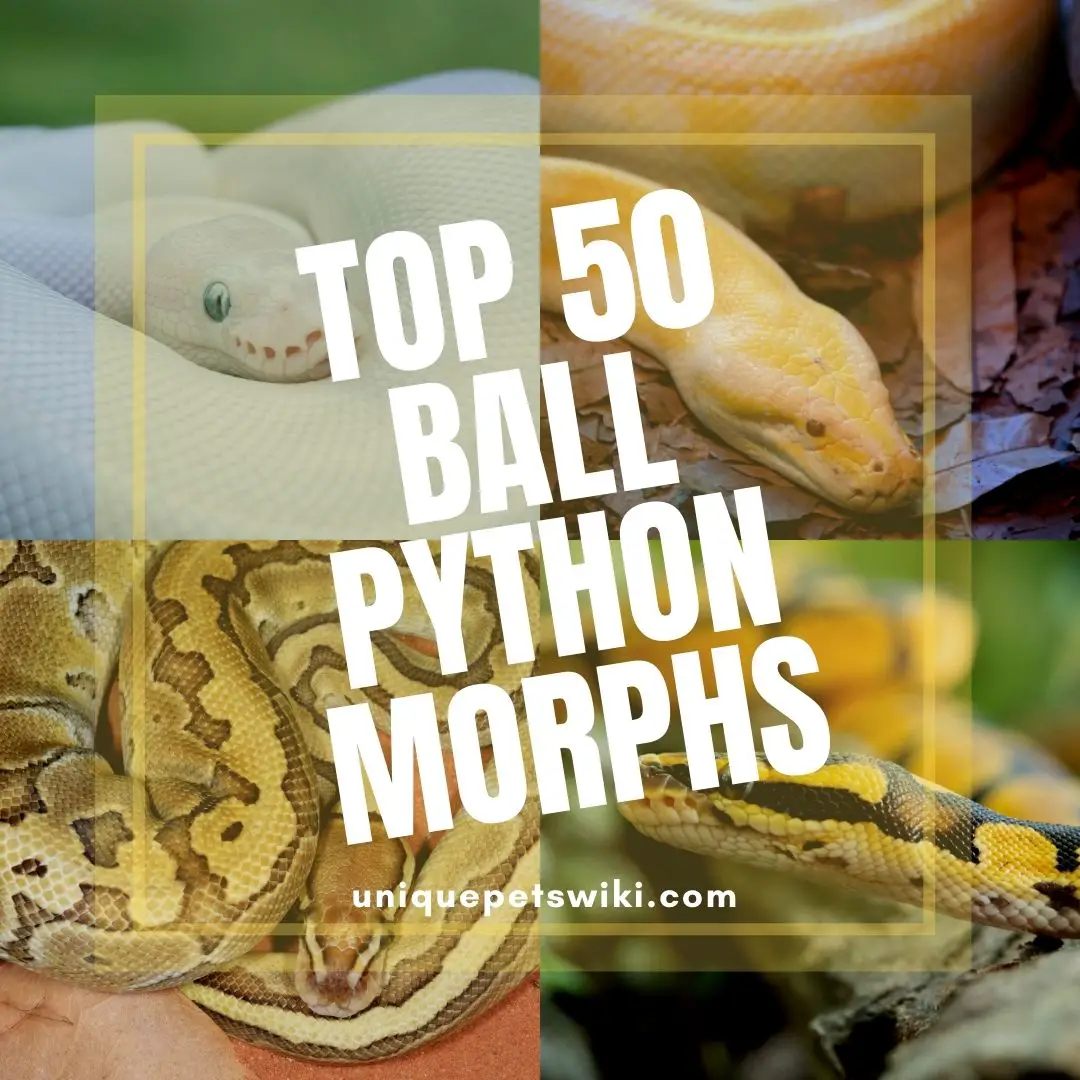Ball pythons are docile, friendly, only grow 3-5 feet, and have a long life span. Thus, they are the most recommended pet snakes for beginners. Here are the top 58 ball python morphs (Included 8 morphs created in 2020).
There are plenty of ball pythons available in the market. Thus, before deciding to purchase one, you must be ready to choose from thousands available ball python morphs.
Ball python morphs are bred by isolating mutations to create different patterns and color variations.
There are more than 7,000 different morphs of ball pythons in captivity. The number continues to grow each year as ball python breeders keep creating new morphs.
If you would love to have a ball python pet, keep reading to understand more about the most popular ball python morphs.
Contents
- What are Ball Python Morphs?
- 58 Ball Python Morphs List – 8 Morphs Discovered In 2020
- Dreamsicle Ball Python
- Scaleless
- Acid Ball Pythons
- Blue-Eyed Leucistic
- Blue Eyed Lucy
- White Ball Python
- Highway ball python
- Bongo Pastel
- Bumblebee Ball Python
- Super Blast Ball Python
- Tiger Ball Python (Desert Enchi)
- Albino Ball Python
- Super Fire Morphs
- Super Cinnamon morphs
- Lavender Albino
- Purple passion morphs
- Piebald morphs
- Fire Ivory
- Candy Morphs
- Candino Morphs
- Ivory Morphs
- Corol Glow (White Smokes)
- Woma
- Banana Ball Pythons
- Axanthic Morphs
- Lemon Blast
- Champagne Morphs
- Pewter Morphs
- Black Pastel
- Clown Ball Pythons
- Mystic
- Spotnose
- Ringer
- Super Pastels
- Spider Ball Python Morphs
- Lesser
- Butter
- Pinstripe
- Vanilla
- Ghost
- Red
- Phantom
- Chocolate
- Ghi Ball Python
- Enchi
- Yellow Belly
- Stormtrooper Morph
- New Ball Python Morphs Discovered In 2020
- How much Do Ball Python Actually Cost as Pets?
- Summary
What are Ball Python Morphs?
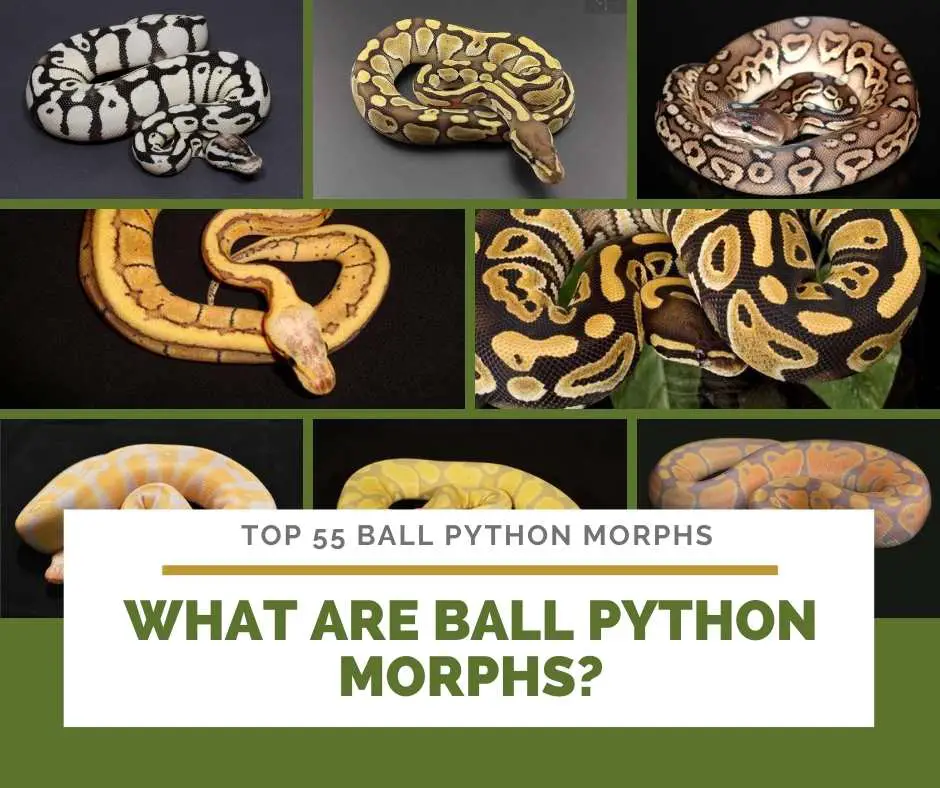
Morphs in animals refer to the same species of animals with different patterns and color variations.
Thus, ball python morphs are ball pythons that have been selectively bred through isolating mutations to create ball pythons i.e (spider, albino, chocolate)with different patterns and colors from their parents.
Just like humans, ball python genes can be passed from parents to babies. Thus, the genes can either be recessive, dominant, or codominant.
- Codominance
Codominance can only occur when the offspring inherits one allele from each parent who has incomplete dominance. The inherited genes allow the amalgamation of noticeable traits
- Dominant
It occurs when one dominant allele hides the effects of the second one and dominates the pattern and colors.
- Recessive
Recessive alleles are unnoticeable unless they are paired with another recessive trait.
Just before we jump into our list of ball python morphs, let’s look at some of the terms that you should try to understand.
Alien Heads are like two eyes since they are distorted heart-shaped blotches containing two proportioned dark spots.
Base morphs are snake morphs in which the genes naturally changed, creating new variations in the wild.
Blushing – it is seen when the base color of many snakes fades.
Designer morphs – when the breeder chooses breed two basic morphs that have very minimal chances of naturally occurring to create new patterns and colors.
Flaming – These are lighter colors that border the keyhole’s sides with a dark central spot.
58 Ball Python Morphs List – 8 Morphs Discovered In 2020
| Morph | Colors | Price ($) |
| Acid | Can either be black or brown base color and golden brown blotches | $1500-$3500 |
| Axanthic | Brown, white, gray, silver | $200 |
| Albino | They have a very bright yellow base color, white spots, and bright red eyes. | $250-$400 |
| Black (Black-Backed) | Concentrated thick and unbroken stripe down the spine | $50-$100 |
| Banana | Brown or tan base with yellow spots | $150-$250 |
| Blue Eyed Leucistic | Pure white body with blue eyes | $800-$1000 |
| Black Pastel | Black base colors with gold or rust patterns | $1000 |
| Bongo Pastel | Black base color with whitish fade towards the belly | $300-4500 |
| Blue-Eyed Lucy | Faint yellow dorsal stripes and blue eyes | $700 |
| Butter | Caramel-brown background with yellow markings | $100 |
| Bumblebee | Yellow background with black lines and dots | $450 |
| Candino | Bright yellow separated with small pink stripes and pools | $300 |
| Candy | Base colors are either dark lavender, beige, or gray with bright yellow patterns | $350 |
| Chocolate | As the name suggests, dark chocolate brown base, colored caramel keyhole, plus alien head spots | $100-$250 |
| Champagne | Dark brown background color and a light stripe down the spine | $200 |
| Clown | Brown and tan background colors with copper undertone | $200 |
| Cinnamon | Rich brownish-red background with bronze rings | $450 |
| Dreamsicle | Can either be pinkish or white with clouds | $2500 |
| Coral Glow | Dark lavender background color with bright orange spots | $250 |
| Fire | Coffee brown background | $100-$400 |
| Enchi | Tinted orange sides, and blushing round pattern at the back of the head | $100 |
| Fire Ivory | Pink-lavender background with a greyish blushing | $375 |
| Ghost | Yellow, lighter tans with a gray flaming sides | $100 |
| Ghi Ball Python | Black base with bright colored belly | $100 |
| Highway | Copper brown – gray-brown | $550-$650 |
| Ivory | They are Pink-white color with no patterns and a thin yellow stripe down the spine. Ivory morph has black eyes. | $200-$300 |
| Lemon Blast | Fine-line black color patterns and bright yellow background color, and pale green/amber eyes | $200 |
| Lavender Albino | Lavender base color-sharp yellow patterns and golden yellow undertones | $400 |
| Mojave | Dark brown base to bluish-black | $100-$600 |
| Mystic | Dark brown base fading to tan color near the belly | $150 |
| Pastel | Intensified yellow pigmentation, white lips, and green or pale eyes | $75 |
| Phantom | Black color base fading to tan towards the white belly | $100 |
| Pewter | Light-brown base color and a thick stripe along the spine | $200 |
| Piebald | White base color with erratic pattern patches | $300-$400 |
| Pinstripe | Light brown base color with a thick stripe | $100 |
| Ringer | Dark and light brown patterns with a white belly and a white ring near the tail | $150 |
| Red | Deep red and undertone blotches | $100 |
| Purple passion | Lavender pink body without any patterns at sides | $400 |
| Scaleless | Do not have scales except for the belly | $600-$2500 |
| Spider | A tan-brown base that is pale along the spine | $150 |
| Stormtrooper | White black and grey markings | N/A |
| Spotnose | Fading light brown blotch pattern on a dark alien head | $150 |
| Super blast | Bright pastel yellow color | $325 |
| Sunset | Concentrated auburn-red with copper spotting colors | $1000-$1500 |
| Tiger | Light yellow base color fading to orange hue towards the sides | $200-$400 |
| Vanilla | Brown blushed out base color and a faded head | $100 |
| White | Standard dark eyes with no pigment body | $650 |
| Woma | Has brown sides that lighten along the spine | $250 |
| Yellow belly | Tint yellowish belly and a speckled pattern at the border of their scutes | $50 |
| Mojave Albino Pied | Pure white with small yellow patterns around the head and the neck | $1400 |
| Enchi Pied | Has the Enchi patterns and colors but its orange is more defined, and white portion like the piebald | $400 |
| Albino Pied | orange leopard-like patterns and a piebald tail pattern | $800 |
| NR Mandarin Pastel Enchi Fire | Looks more like the leopard but with faded colors | $4000 |
| Ghost Pied | Yellow, brown shades, a faded head with larger piebald white patterns | $750 |
| Pastel Ghi Clown | Ghi, pastel, and Clown | $1250 |
| Lesser Ghi Ultramel | Light yellow + White | $2000 |
| Bumblebee Freeway | Asphalt + Pastel + Yellow belly | $1100 |
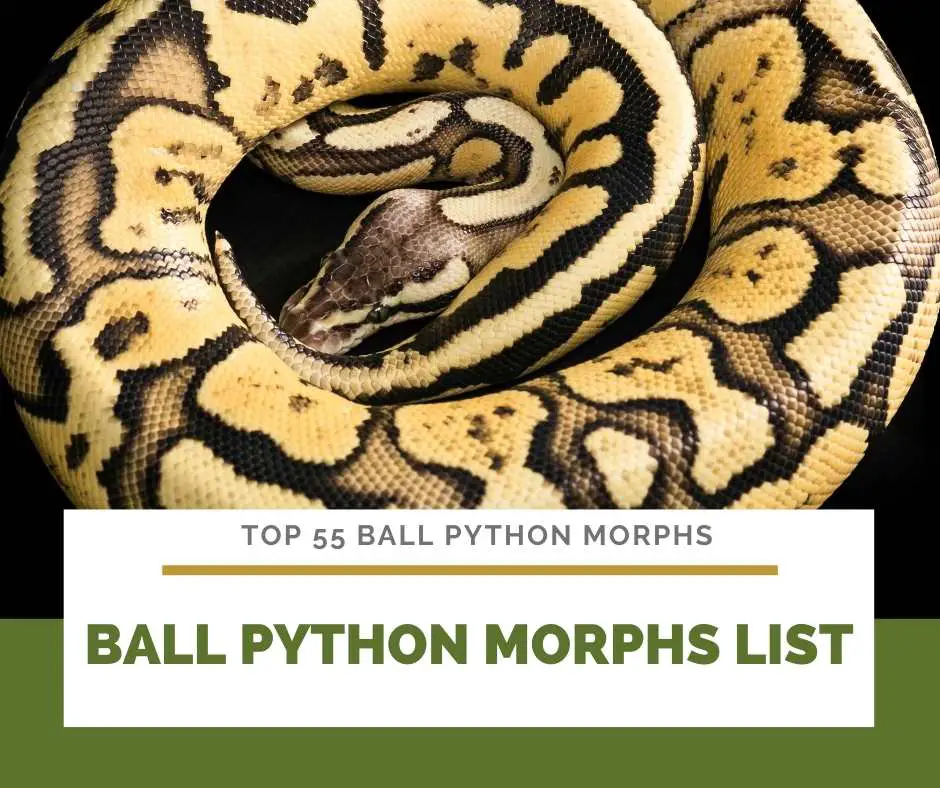
Top 58 Ball Python Morphs (8 morphs found in 2020) starting from the most expensive.
Dreamsicle Ball Python
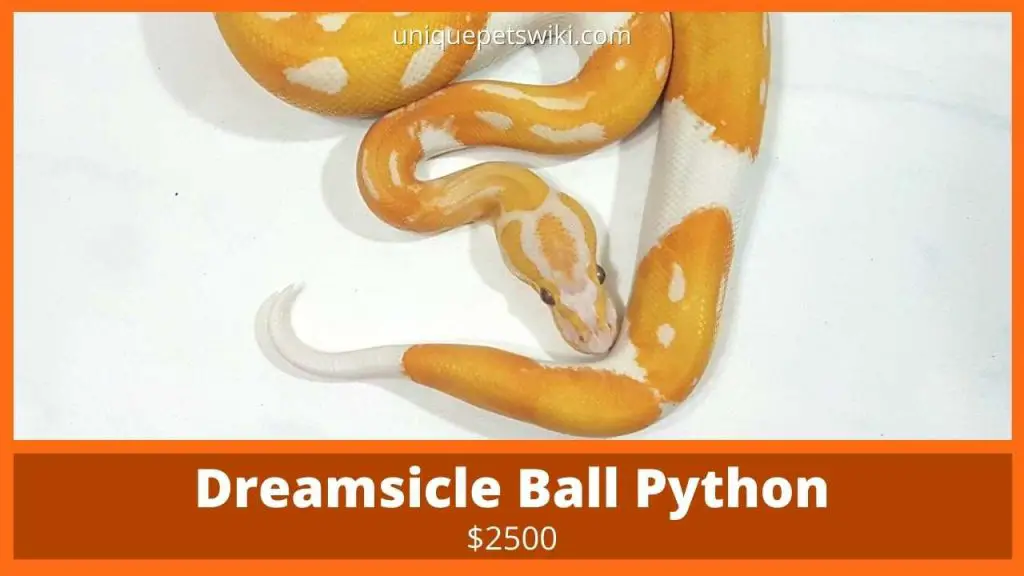
To get a dreamsicle ball python, you need to breed approximately 2-4 generations to acquire a combination of an Albino-Lavender and a Piebald mix.
Lavender, Piebald, and Albino carry recessive genes. Thus, they are harder morphs to produce.
Dreamsicle snakes are either whitish or pinkish, with cloud patterns randomly spread along their body.
They also have bright orange blotch that contains white spots. These traits are never present in a normal piebald.
Dreamsicles are the most sought after morphs since 2007, making them the most expensive. A single dreamsicle morph costs from $2,500 and above.
Scaleless
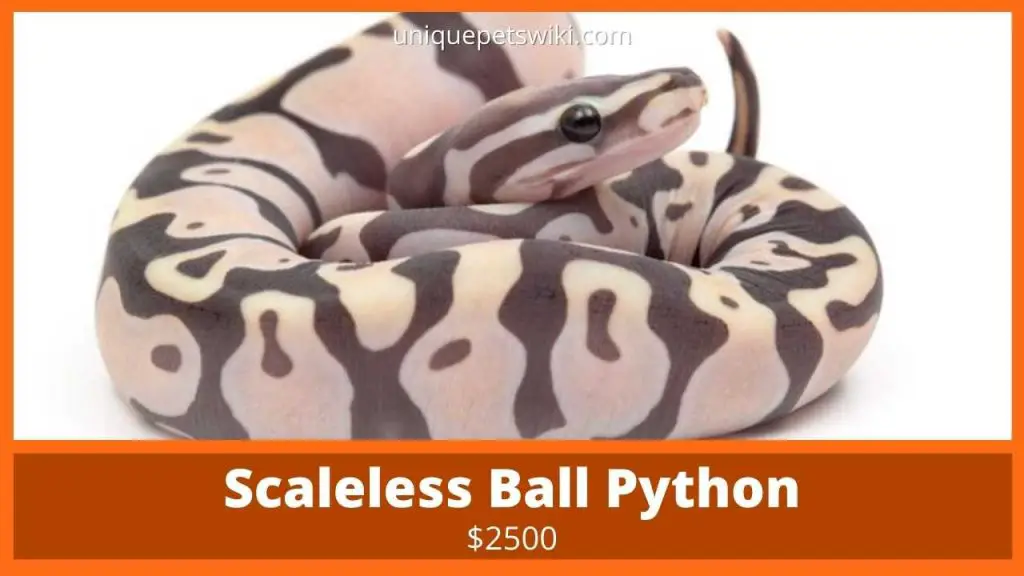
(Image source: worldofballpythons.com)
Scaleless have skinks instead of scales, making them the most unusual morphs in the list.
Some have no scales at all while others have a few skin patches. However, they all have belly scales known as scutes to help them to move across the ground.
They were first produced in 2013 from scaleless-head morphs, and a single morph goes for approximately $2500.
Acid Ball Pythons
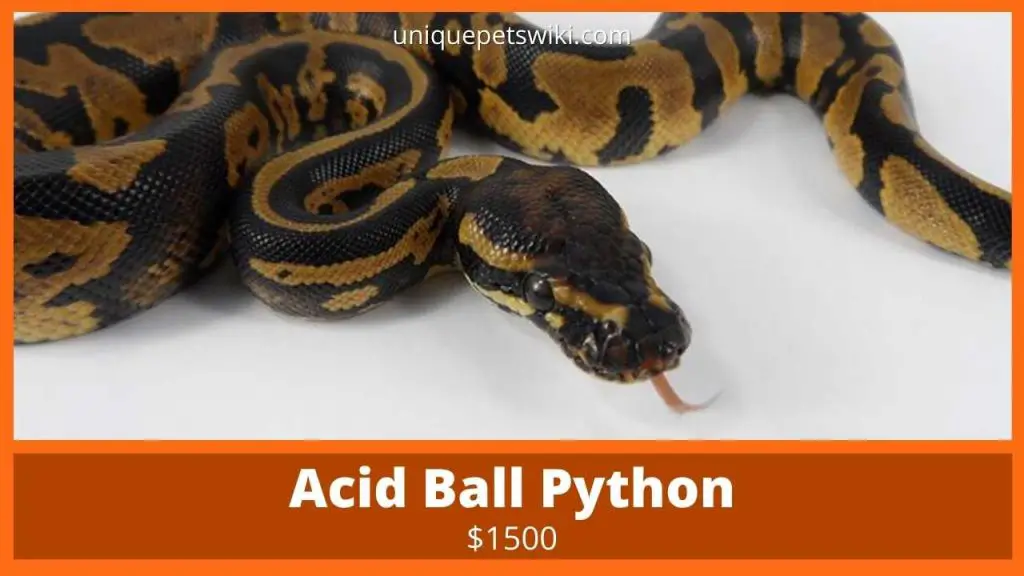
(Image source: worldofballpythons.com)
It is one of the new morphs that were first produced in 2015. Since then, they have been popular among ball python breeders, and a single morph can go for approximately $1500.
Acid ball pythons carry the dominant gene, and thus, they can overtake ivory gene patterns. When you breed it with any other morph, it has a very high possibility to shatter their patterns.
They have either a dark brown or black background color and golden brown spots that resembles a normal pattern that is broken.
Acid ball pythons also have a yellowish belly with a zipper-like line along with it. Their belly pattern gives them their unique feature.
If you would love to own an acid ball python, be ready to part with at least $1500.
Blue-Eyed Leucistic
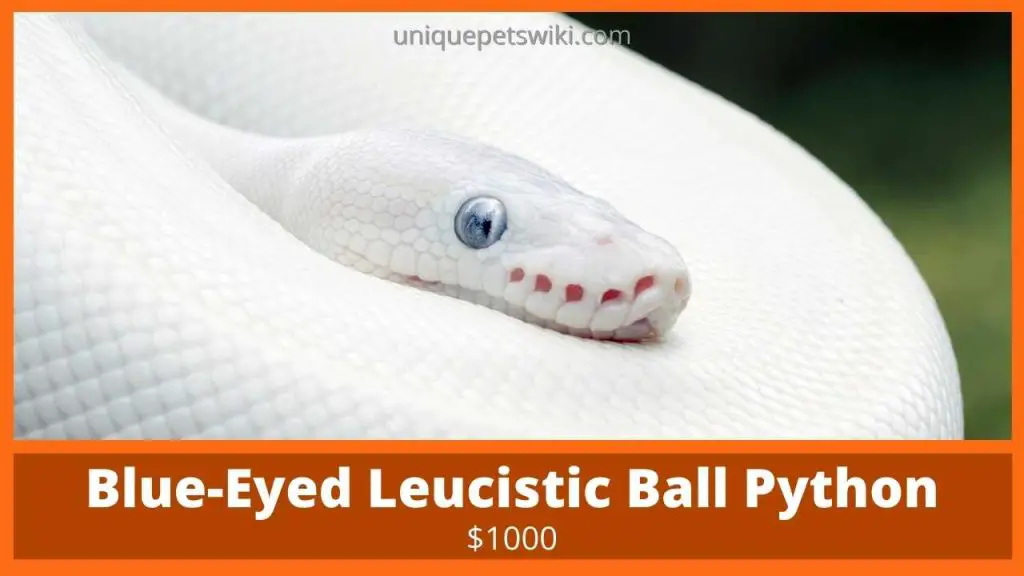
It is another rarest morph that requires you to breed at least five morphs (Lesser, Mojave, Butter, Russo, and Phantom).
Breeding the five morphs does not guarantee Blue-Eyed Leucistic as it can take you 2-4 generations before producing the morph.
Blue-Eyed Leucistic have an elaborate genetic makeup. Thus, even after breeding the five morphs for up to 5 generations, producing a perfect Blue-Eyed Leucistics is never a guarantee.
For these reasons, the blue-eyed leucistic can cost up to $1000.
Blue Eyed Lucy
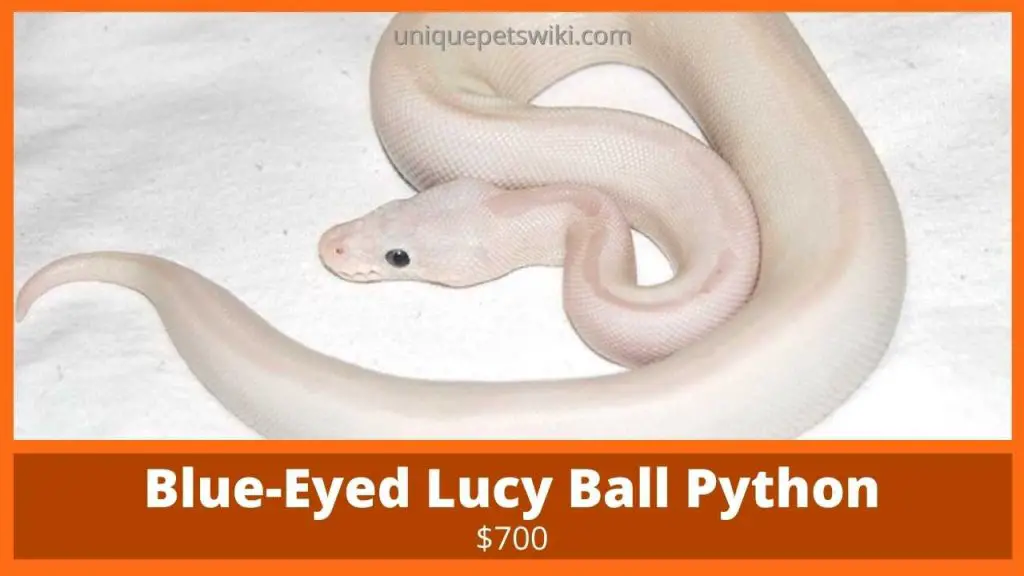
Blue-eyed lucy also has a genetic complex just like blue-eyed leucistic. They are bred from lesser and Mojave morphs.
Most of these blue-eyed lucy morphs have stripes on their dorsal that are faint yellow. Unlike blue-eyed leucistic, they are less desirable.
However, Blue-eyed lucy is not sensitive to excessive light like leucistic and albinos.
Even though so, a single morph of blue-eyed lucy can cost you up to $700.
White Ball Python
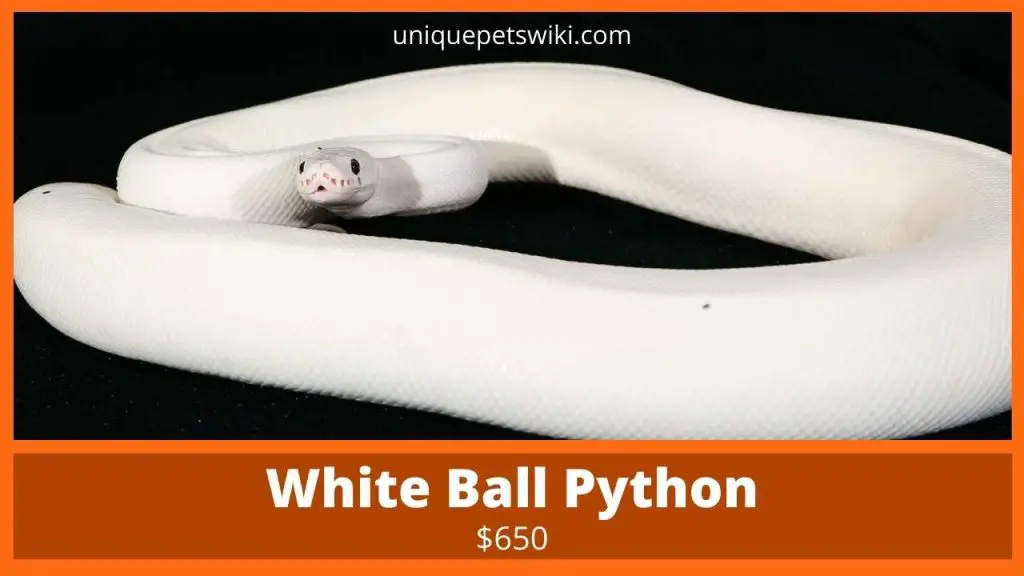
(Image source: animalscene.ph)
The white ball python was accidentally produced in 2007. It was on the breeder’s wedding day that the ball python was hatched in a clutch. For this reason, the breeder named the morph white wedding.
White weddings are one of the cleanest pythons as it does not contain any pigmentation. However, it has leucistic patterns, and they maintain the standard dark eyes.
Since producing these snakes has been successful and they sell at $650 per morph.
Highway ball python
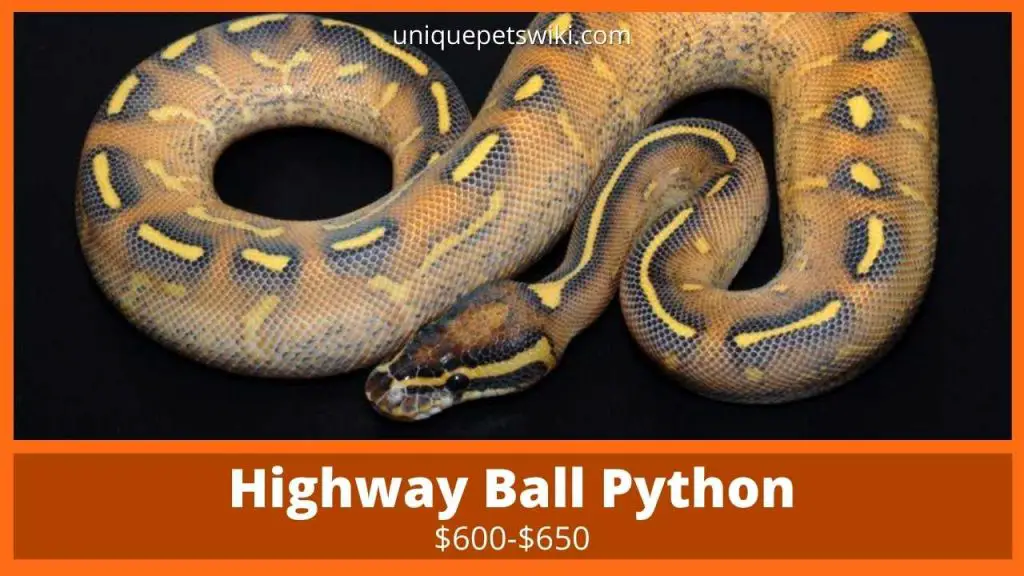
(Image source: pinterest.com)
The designer morph has incredible patterns and is created by crossbreeding a yellow belly and gravel.
They have a brown to the grey base color. However, some have a pastel yellow color, and others have a solid color through their bodies, while others have small rings.
Regardless of color, they all have a common pattern of yellow-broken strips along their spine. Some of these stripes have a dark shadow brightening the patterns.
The price of a highway morph depends on their contrast and gender. Females tend to cost more than males in all morphs. The highway ball python can cost between $600-650, and females are costing more than this.
Bongo Pastel
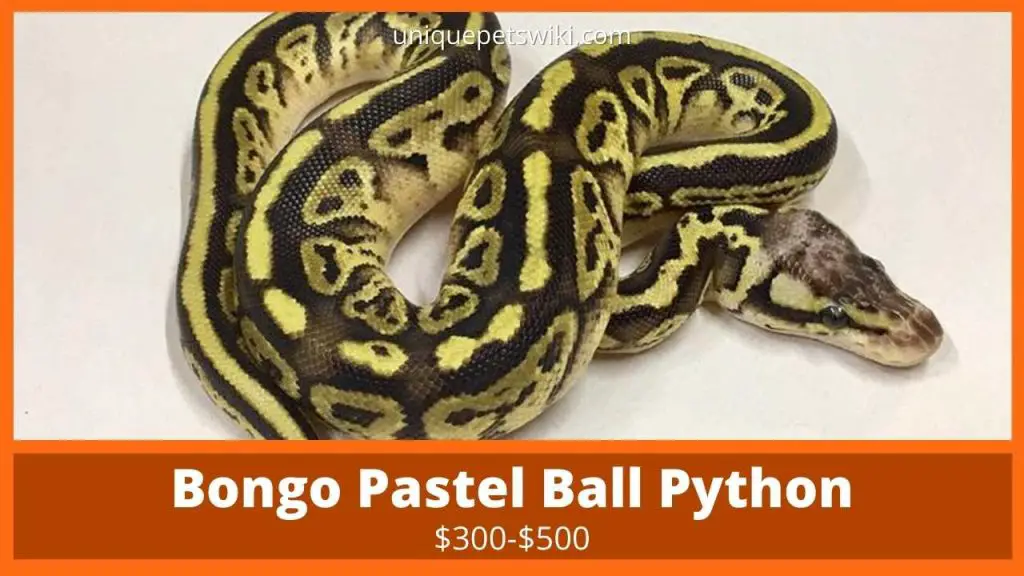
(Image source: worldofballpythons.com)
It was first produced in 2012 by mating a pastel morph with a bongo. The Bongo Pastels base color is brownish-black that fades to white towards the belly sides.
Bongo Pastels have a similar pattern to Bongo except for the reduced markings along the spine. Also, they have alien-head blotches with black centers along the sides.
However, Bongo Pastels blotches are bright yellow and are outlined by blushing base color sections due to the pastel gene.
Depending on coloration quality, a bongo pastel cost $300 – $500 for the ones with bright contrast.
Bumblebee Ball Python
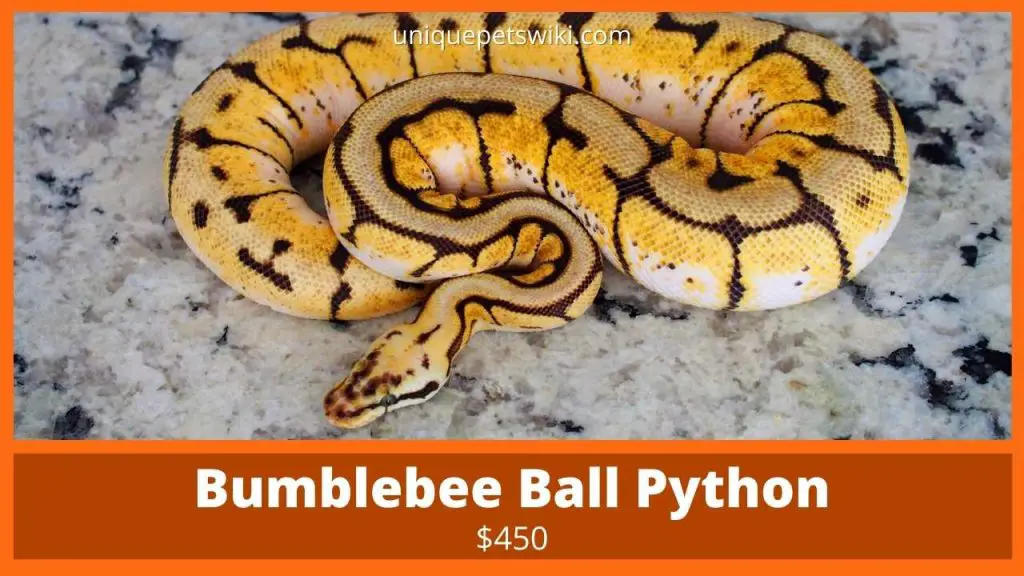
The intricately patterned Bumblebee ball is bred from spider and pastel genes.
The Bumblebees mostly have a tan-yellow base with black stripes and spots, and white specks. Bright yellow morphs are known as Killer Bees. Killer Bees retain the bright colors into adulthood, unlike the rest who fades with age.
Bumblebees are mostly loved for their patterns. And, breeders use the morph to produce vivid colors in other morphs.
Bumblebees with darker tan-yellow variations cost less than killer Bees. The approximate cost of a killer bee is $450.
Super Blast Ball Python
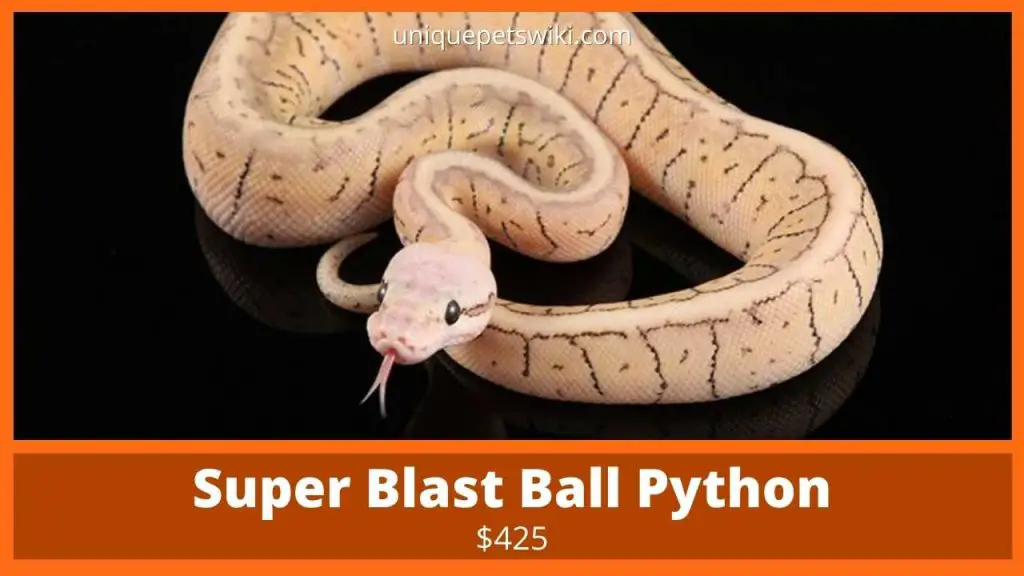
(Image source: worldofballpythons.com)
Super Blast is a designer morph created by combining three different genes (Super Pastel and Pinstripe).
Super Blasts receive a lot of attention dues to their beautiful appearance. They have bright pastel yellow color, with a thin, black faded vertical line along the sides.
Super Blasts also have a unique trait of a dark spot in their face. Currently, a super blast morph can cost you $425.
Tiger Ball Python (Desert Enchi)
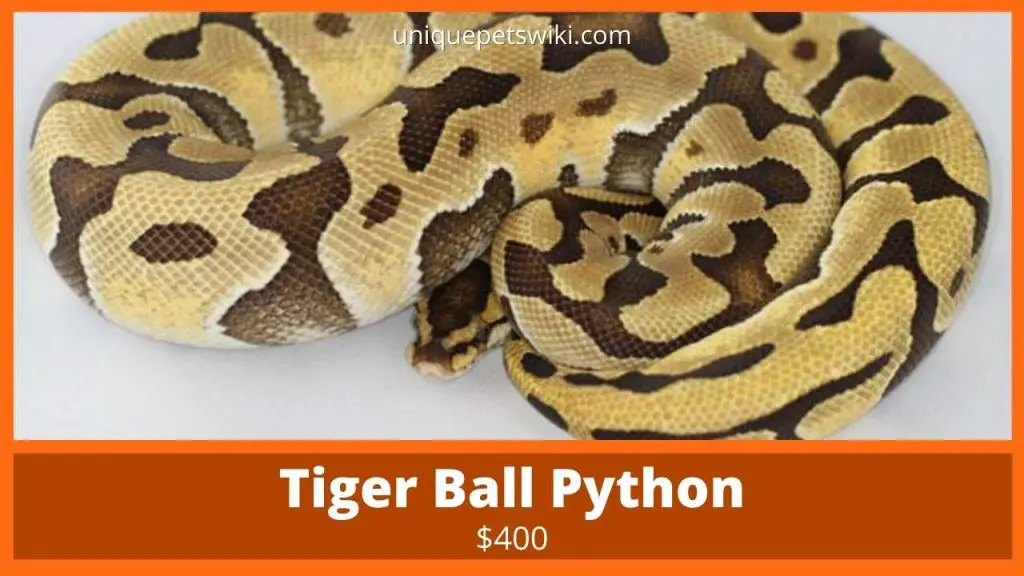
(Image source: worldofballpythons.com)
Even though their origin is not clear, they are a designer morph that is bred from combining a dominant desert gene and a codominant gene of Enchi morph.
They have a light yellow base color that fades to orange hue towards the sides. They have a dark brown band through their back, spots, and horizontal, short, stripes patterns.
Additionally, tiger morphs can be identified through their dark nose and heads, and light face and mouths along the sides.
The price of one morph depends on their color contrast. A darker morph can go at $ while a lighter morph can go for $400.
Albino Ball Python
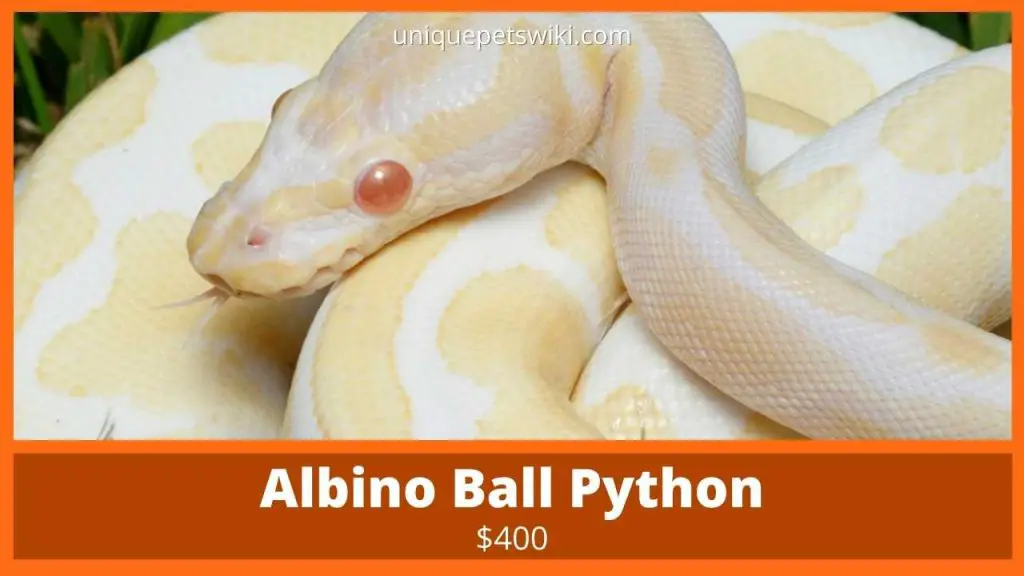
It was the first recessive morph that was bred in 1992. As the name suggests, the albino morphs lack the natural pigmentation in their skin and eyes. Thus, they do not produce black, brown, or red pigments in their scales.
Therefore, albino morphs have bright yellow patterns and glowing red eyes, which make them attractive. The yellow trends fade out to various shades as they grow and depend on the gene used to breed other morphs.
The Albino morphs are currently popular and can be purchased at $400.
Super Fire Morphs
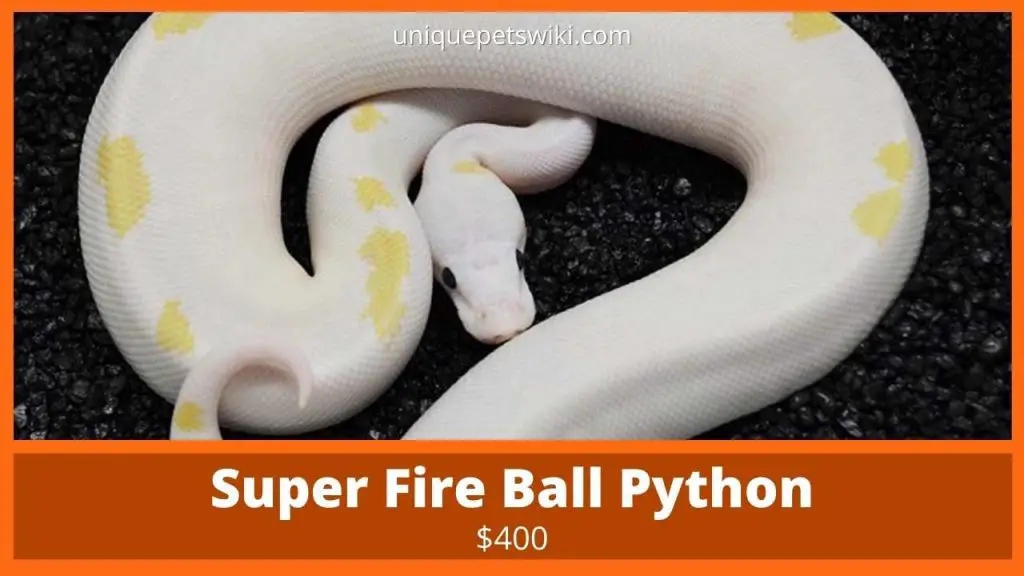
(Image source: worldofballpythons.com)
The first Fire morph was created in 1995 by mixing two codominant genes to create a morph with a coffee brown color with a thick tan banding pattern.
When you mate them together, the codominant gene fires up the color and patterns, and a super fireball is bred.
Thus, super fire morphs are white but have various yellow spots along their spine. They have red pupils, and since they physically resemble leucistic morphs, they are also known as Black-eyed Leucistic.
The first came to existence in 2002. One morph can be bought at $400.
Super Cinnamon morphs
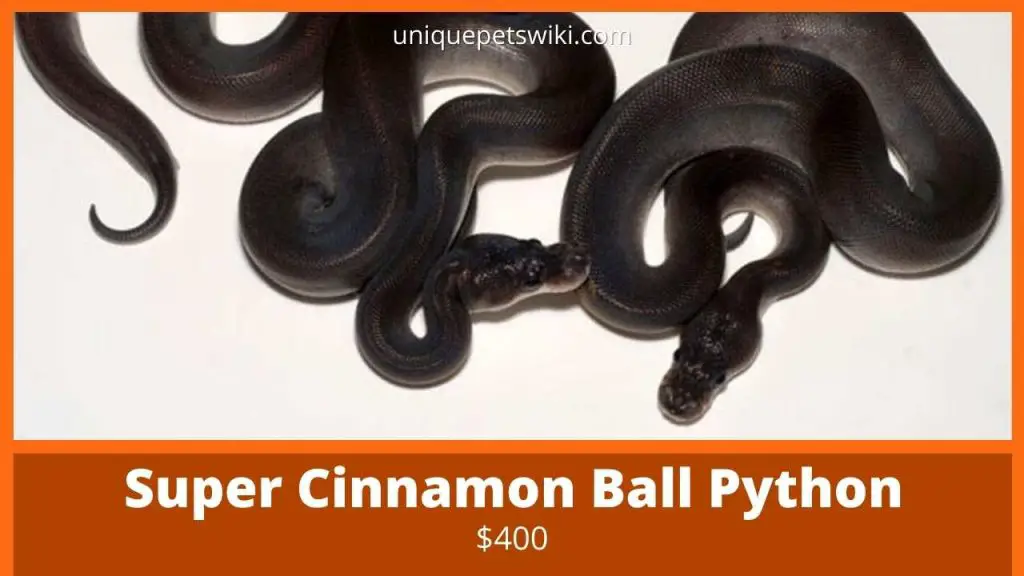
(Image source: worldofballpythons.com)
When you breed two cinnamons, they produce a super cinnamon morph. The cinnamons have a brownish-red base color and bronze rings that are bordered with black shadows.
When you breed them together, they produce a patternless morph that is dark-brownish and fades as it matures. Super Cinnamons are light, plain belly can also identify them.
Their faded color turns more like cocoa color; they are also known as blackball pythons.
Super Cinnamon morphs are more expensive compared to regular cinnamon morphs. The super costs approximately $400, while a monthly cinnamon costs as low as $75.
Lavender Albino
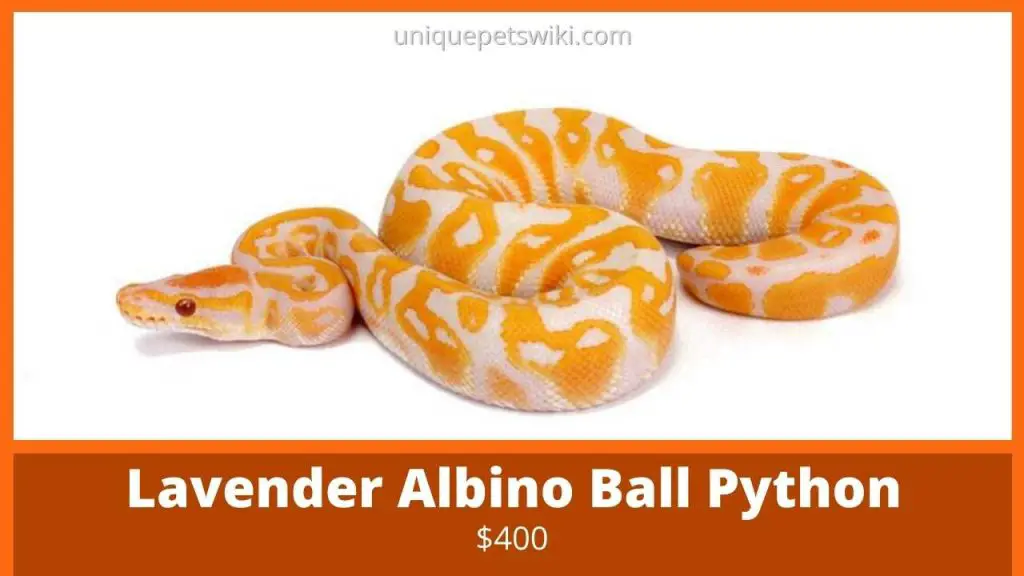
(Image source: worldofballpythons.com)
The first lavender Albino, was sold at $40,000 in 2001. The morph was bred by mixing the recessive Albino gene with Lavender traits.
Thus, they technically have a lavender base color with bright yellow patterns and red eyes. Their high, contrast colors and clear patterns make them more valuable.
Most breeders can now easily produce these morphs, and thus their prices have gone down to $400.
Purple passion morphs
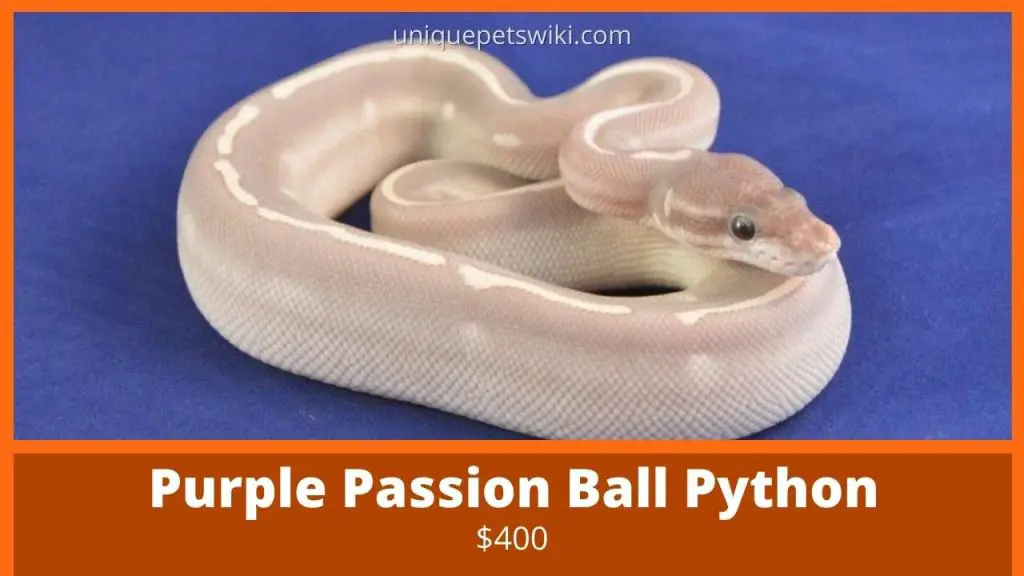
(Image source: worldofballpythons.com)
Purple Passion morphs can be produced by mating Phantom and Mojaves, which are codominant genes.
They were first bred in 2007. And purple passions have a lavender-pink base, and they do not have any patterns on their sides.
Purple Passion morph’s spines have a light, off-white stripe, and their eyes are dark. Some come with circular spots with keyholes, while others vary in the color contrast.
A purple passion morph sells at$400.
Piebald morphs
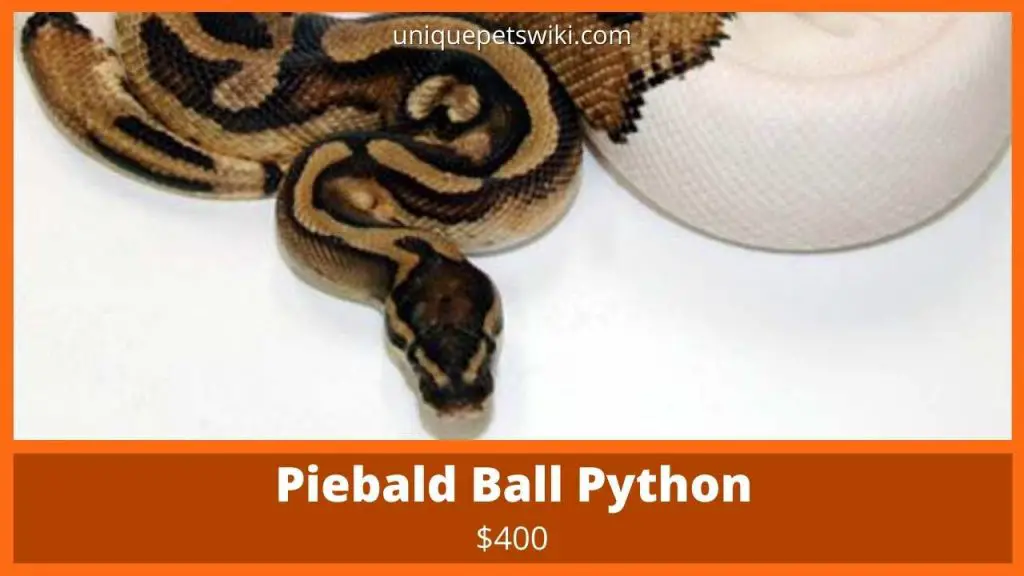
(Image source: worldofballpythons.com)
It is never hard to identify a piebald morph. It is due to piebald’s unique pattern that was as a result of a recessive gene.
They have a white base color, with erratic patterns, and a typical colored head.
The original piebald morph was bred in 1997. Since then, they have been readily available in the market. One morph sells at $400, but the prices can depend on how much white color is showing.
Fire Ivory
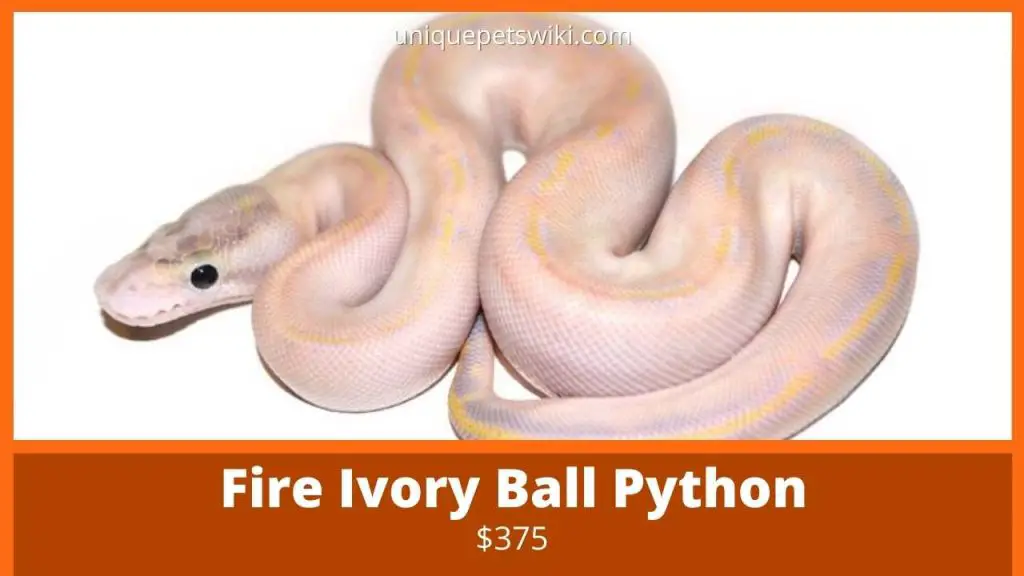
(Image source: worldofballpythons.com)
These unique morphs were first bred in 2012 after crossbreeding a fire morph with an Ivory. It has three genes as it carries a yellow Belly codominant gene as well.
Fire Ivory base color is pink-lavender with grey blushing that makes them look dirty. They do not display any patterns except for a yellow stripe along their spine.
A morph of Fire Ivory can cost you up to $375.
Candy Morphs
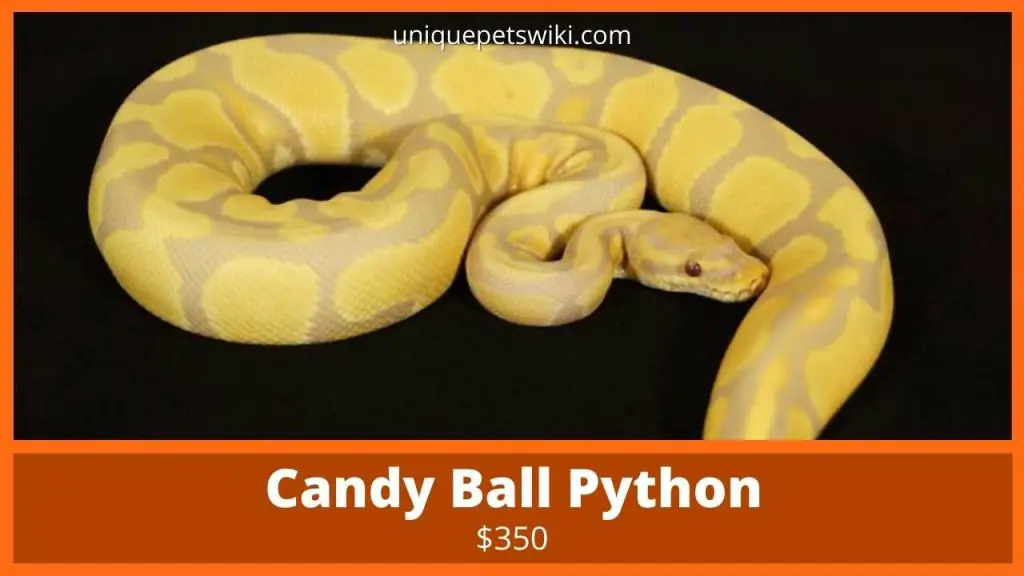
(Image source: worldofballpythons.com)
Candy morphs were naturally bred in African bushes. The first morph was recognized in 2009. Unlike most other pythons, candy morphs get more desirable with age.
During hatchling, they look more like Albinos. But, their colors change as they mature, turning to dark lavender, beige, or grey. However, they still retain their bright yellow patterns.
They carry a recessive gene, but amazingly, they display Albino and Toffee patterns, which are codominant genes.
You can purchase a Candy morph at $350.
Candino Morphs
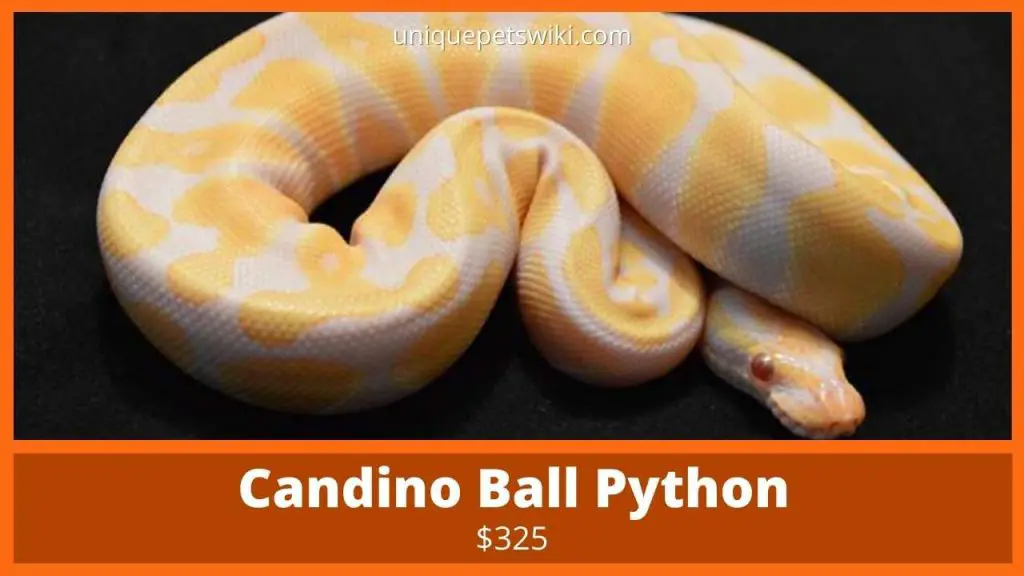
(Image source: worldofballpythons.com)
Candino morphs came into existence in 2012 after cross-breeding recessive Albino and Candy genes. These designer morphs have a rare mutation in such as they can never naturally occur in the wild.
These morphs appear with either light pink or lavender base color and blotched patterns that are bright yellow with a slide fading around them.
These spectacular morphs can be bought at $325.
Ivory Morphs
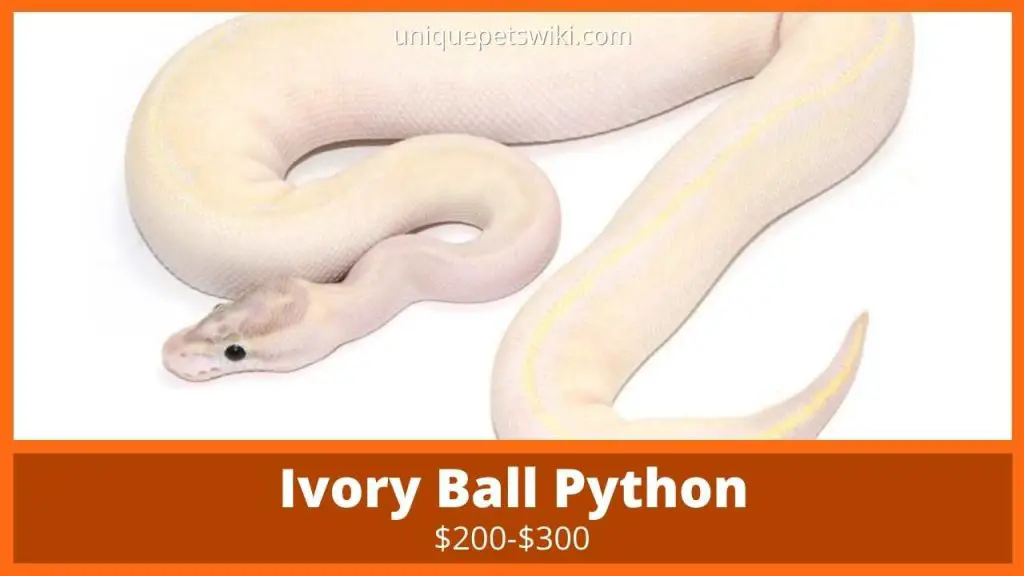
(Image source: worldofballpythons.com)
You can produce an Ivory morph by breeding two recessive yellow bellies. They are designer morphs that do not display any patterns except for a thin yellow band along their spine.
You can identify Ivory morphs as they display blushing lavender-grey color on their heads. Occasionally, their heads can appear with black or bright yellow patches.
It can cost you approximately $200-300 to purchase a single morph.
Corol Glow (White Smokes)
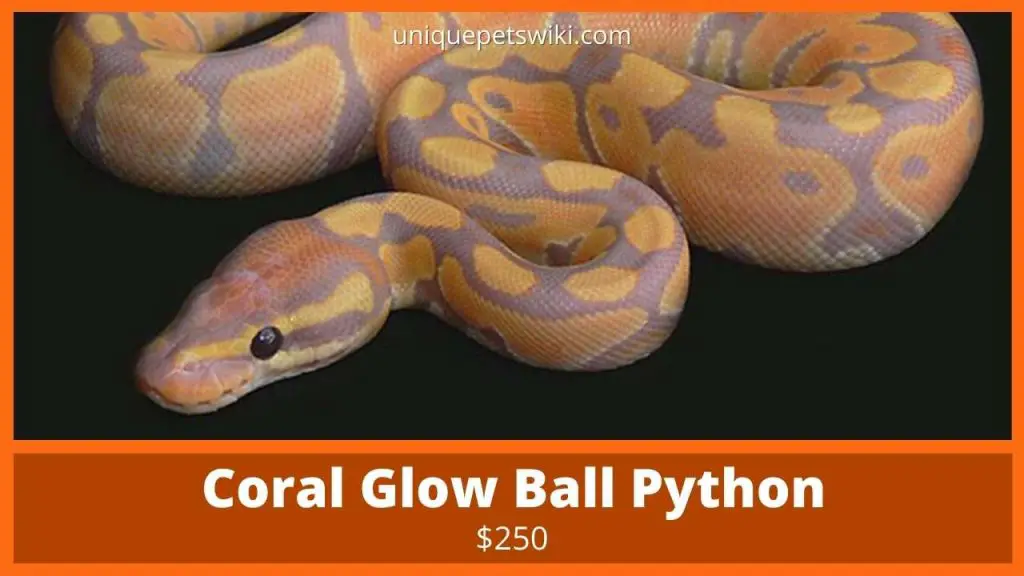
(Image source: worldofballpythons.com)
The Corol Glow or white smoke was first bred in 2002. You can recognize them by their dark lavender base color and bright orange blotches.
Coral Glow morph blotches give a shining impression due to their fading yellow edges.
Some coral Glow morphs look more like banana ball pythons due to their bright yellow patterns with dark specks throughout their bodies.
These commonly known hypomelanistic morphs can cost you approximately $250.
Woma
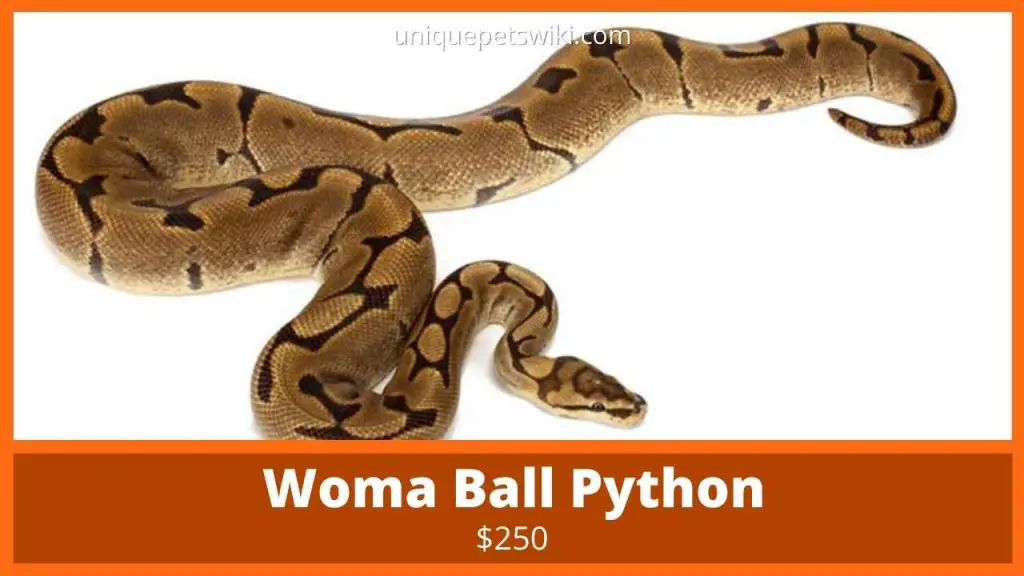
(Image source: worldofballpythons.com)
These morphs are known as the Woma since they have the same patterns as the Woma pythons. The Woma was first produced in 1999, and they carry a basic dominant gene.
The Woma morphs are hard to breed as they produce inconsistent offspring. Additionally, they have a shorter life span, and thus, it is unreasonable to breed two of them together.
The woma morphs have dark heads with mild blushing, and their upper lips are yellow. Their bodies have dark bands that get thinner towards the belly. And their sides are brown that slowly lighten to the spine.
If you would love to own one of these morphs, you can purchase it at $250.
Banana Ball Pythons
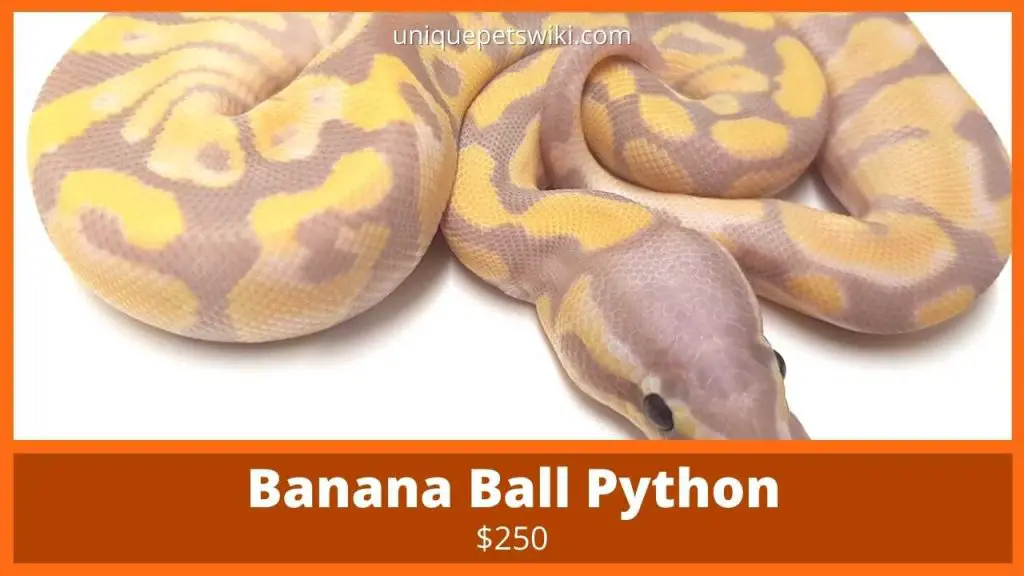
(Image source: worldofballpythons.com)
These beautiful morphs have a tan base color, big yellow blotches. Sometimes they can appear with a yellow body and dark freckles through their bodies.
Banana morphs carry codominant genes, and they were first seen in 2003.
Back then, the first morph was sold at $25,000. But, the price has now gone down to $250. It’s now easy for ball python enthusiasts to get them since breeders have been producing them since 2003.
Axanthic Morphs
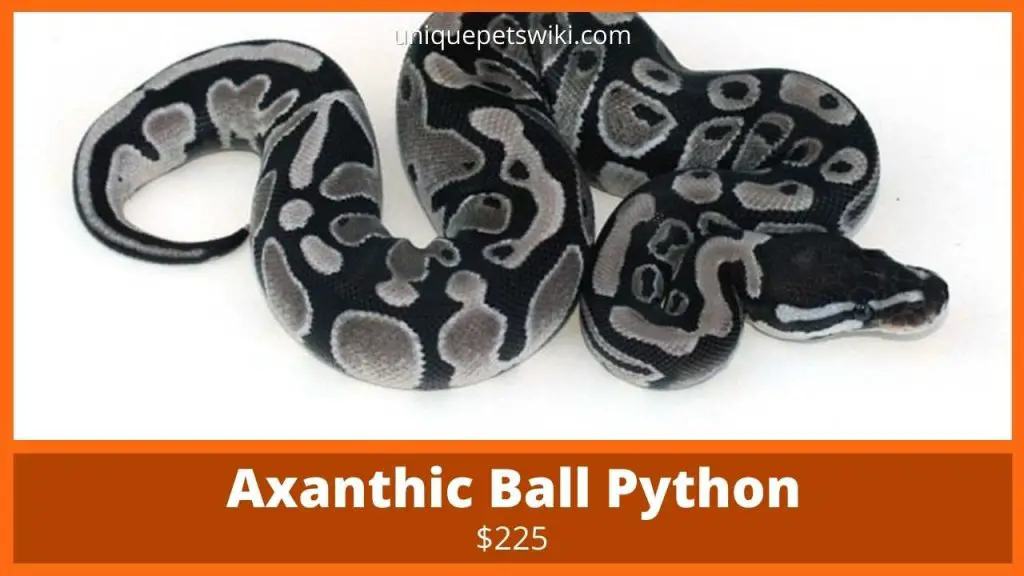
(Image source: worldofballpythons.com)
Just line Albinos lack black, orange, red, and brown colors, Axanthics also lack yellow and red pigments. Thus, these morphs appear with varying black, white, brown, and silver pigments.
Their contrasting ordinary colors tend to turn brown as they mature. Their recessive gene has been in the market since 1997, and they were used by breeders to create more unique ball python morphs.
An Axanthic morph costs approximately $225.
Lemon Blast
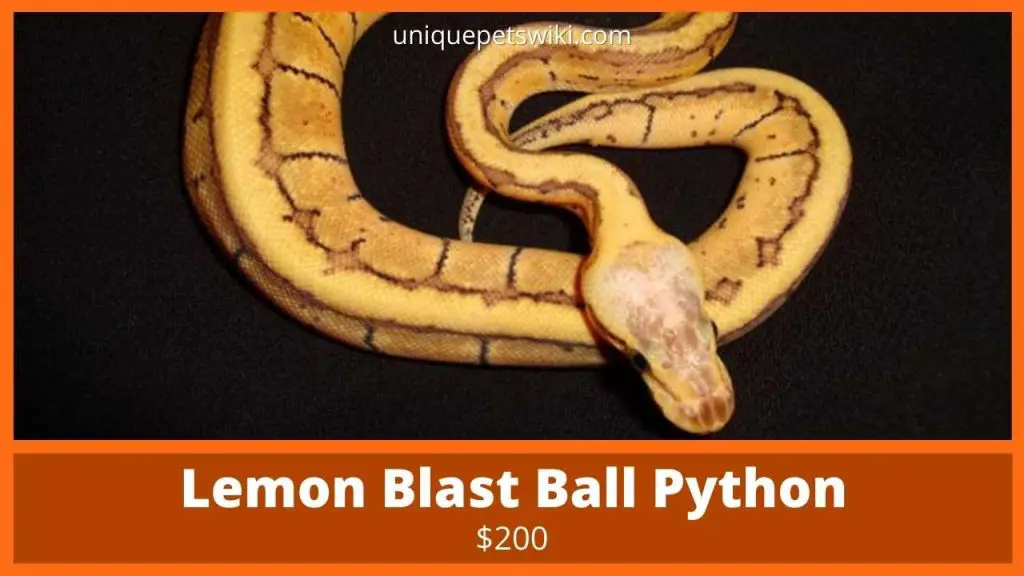
(Image source: worldofballpythons.com)
The first morph of the lemon blast was bred in 2003 after mixing the codominant pastel gene with a dominant Pinstripe gente.
The Lemon blast is a designer morph with a light yellow to a sunset orange base color and dark brown fine line patterns. Sometimes they can appear with flecks of colors all over the body.
They do not have patterns along their spine. And, their bodies have unique patterns that make them appealing.
The lemon blast morph can cost up to $200.
Champagne Morphs
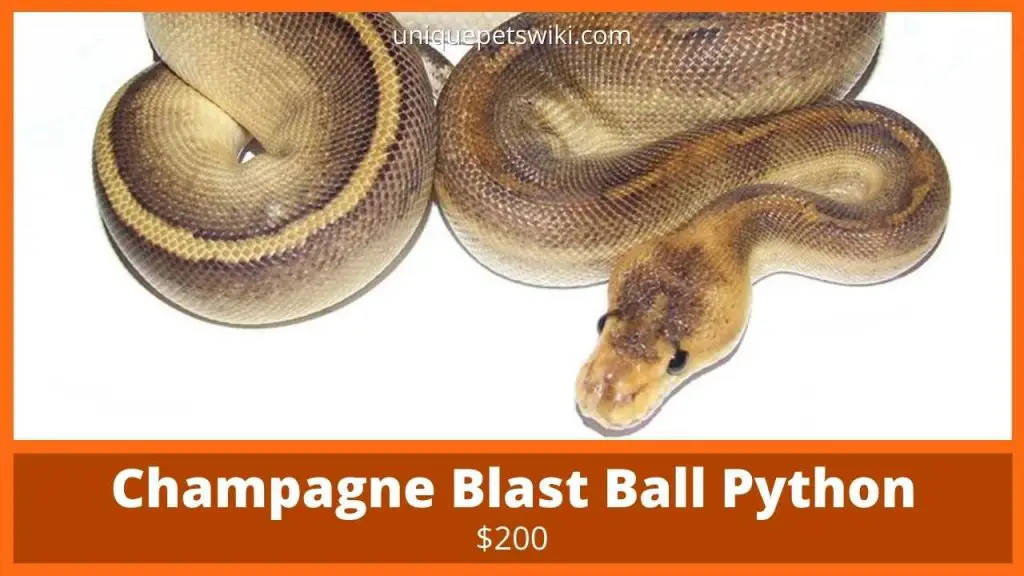
(Image source: worldofballpythons.com)
Champagne morphs are also known as the Puma. They are unique as they do not have any real patterns.
Their base color ranges from tan to dark brown, but they have a light line along their spine.
Ball python breeders use Champagne morphs to create unique patterns in other morphs. When bred together with different morphs, they can either reduce or brighten the patterns.
This character makes them more valuable to breeders who would like to create unique ball python morphs.
The first breed of Champagne morph was bred in 2005. Currently, it can cost you $200 to buy a champagne ball python morph.
Pewter Morphs
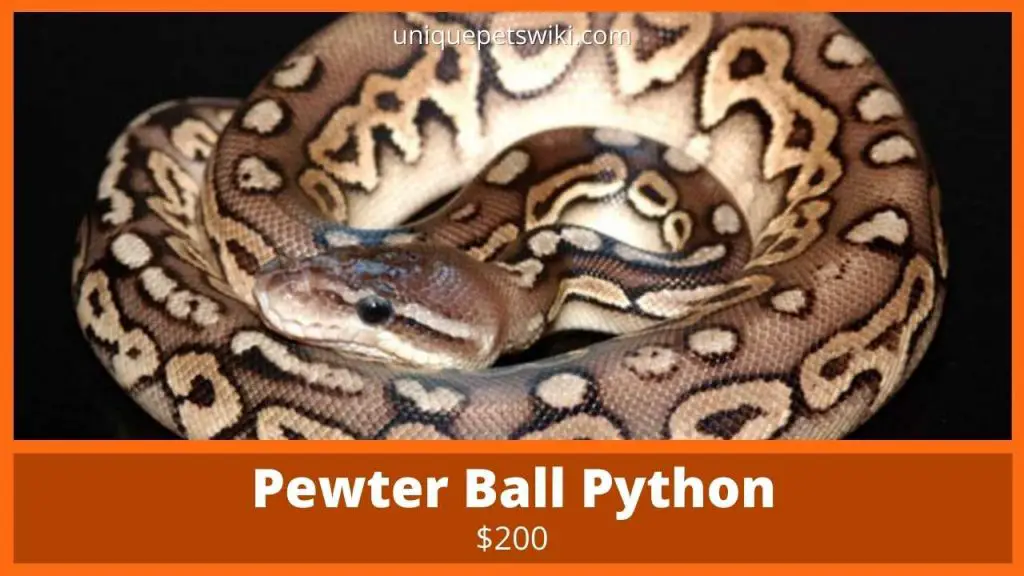
(Image source: worldofballpythons.com)
The Pewter morphs come as a result of mixing a codominant Pastel and Cinnamon genes.
Pewter ball pythons have a tan or light brown base color and a thick line along their spine. Also, they have keyhole patterns that are golden brown, dark brown, or black at the center, and also the borderlines. Others can appear with spots or erratic patterns.
However, they all have uniform patterns and colors. The first breed of this kind was bred in 2003.
You can get a Pewter ball python at $200.
Black Pastel
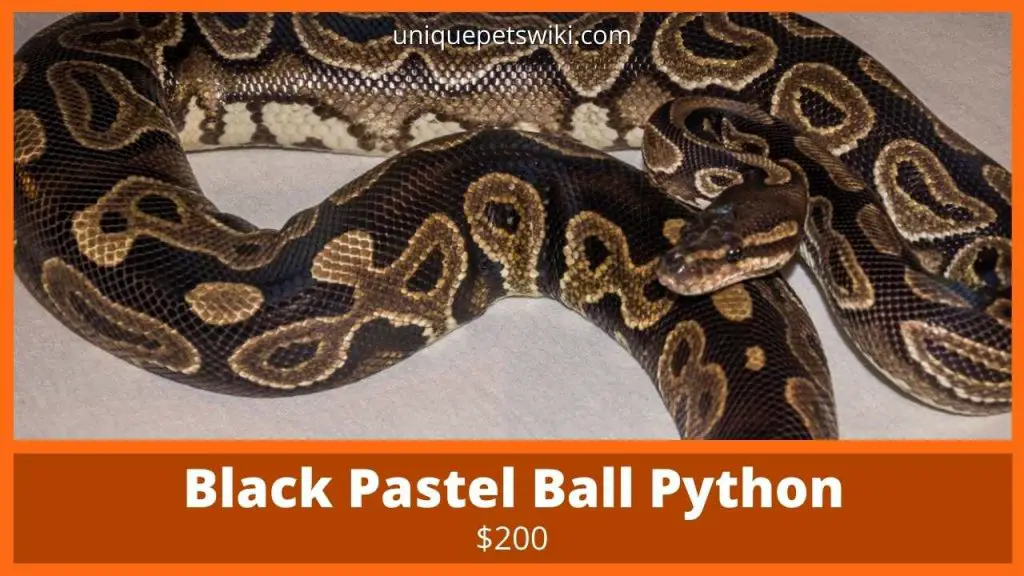
(Image source: worldofballpythons.com)
The black pastel is a codominant gene that was first bred in 2002.
They have a dusky black, dark, grey with shadows base colors. Additionally, they have a blushing pattern.
When you breed two of these morphs, they produce a super black pastel that can either be dark or solid black with patterns.
The super black pastels usually have a black base color with rusty-colored blotches.
You can buy the super pastels at $200.
Clown Ball Pythons
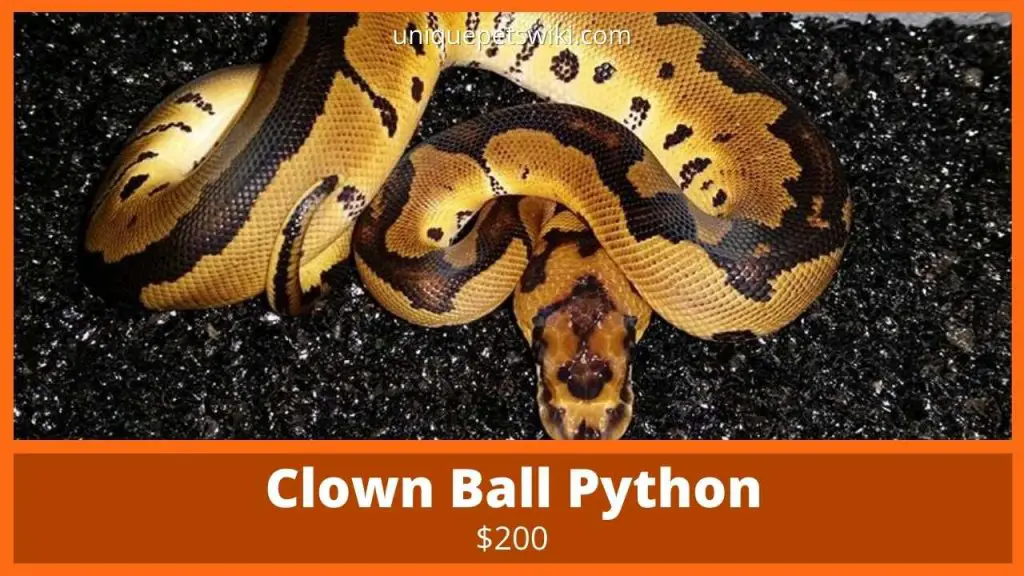
(Image source: worldofballpythons.com)
Clown ball pythons have a copper undertone, fading towards the belly and getting darker with age. Additionally, their base color is either brown or tan.
Clown ball pythons do not have many patterns but they have a dark, thick, stripe along their spine. Their heads are unique due to their intricate pattern that has both light and dark shades.
Clown ball pythons carry recessive mutation genes that typically affect their colors and patterns.
The first morph of this kind had a spot underneath its eye that looked like a teardrop. And thus, the name clown. It was first seen in 1999, and since then, breeders have been producing them.
You can buy this morph for only $200.
Mystic
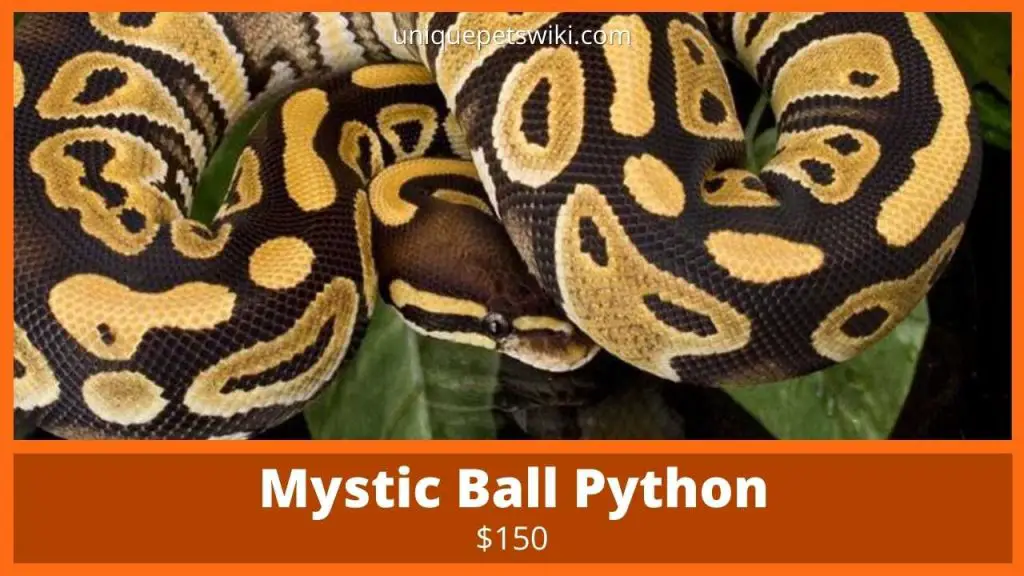
(Image source: worldofballpythons.com)
Mystic ball pythons are rare morphs that were first produced in 2005. They were the first morphs that had a dark brown-black base color that fades to tans to the belly.
As they age, they become even more attractive as their color changes to purplish-grey. Their patterns look more like Mojave except that they do not have the flaming patterns.
Mystic ball pythons either have little or no alien head shapes, and their keyhole blotches display bronze-orange or gold colors. Their heads are dark, and so do not have blushing.
A mystic ball python morph can cost you approximately $150.
Spotnose
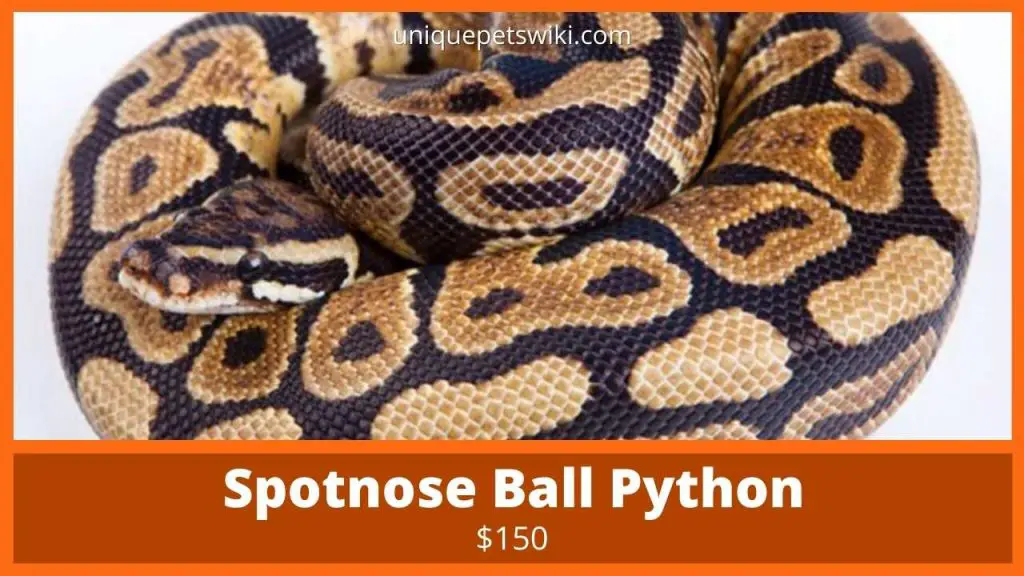
(Image source: worldofballpythons.com)
Are you wondering why these morphs are known as the spotnose? Well, it’s because they have a circular spot on either side of their nostrils.
In 2005, the first spotnose morph was bred from a codominant gene. These morphs have no significant effects on their offsprings except for the facial colors and head patterns.
Spotnoses have more alien heads compared to other variations, and their heads are dark brown with light brown faded spots pattern.
If this morph sounds like an excellent pet, you can get it at $150 from most breeders.
Ringer
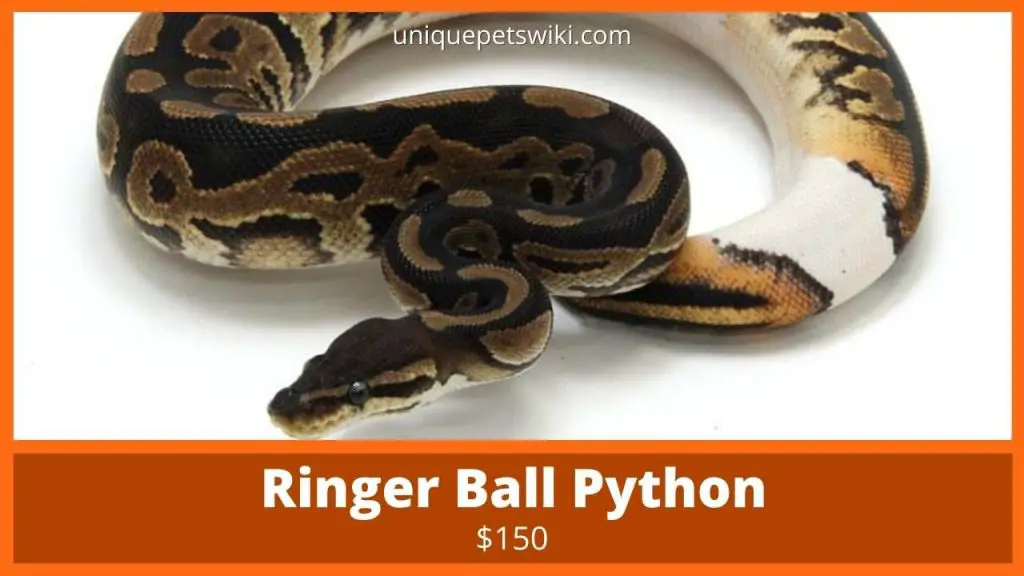
Did you know ringer ball pythons are known by this name due to their white ring-shaped spot at the end of their tails? It is the only character that makes them unique from the usual ball pythons.
Most breeders use them to try creating recessive pied gene offspring. They are 5% pied, but breeding them does not guarantee piebald offspring.
If you would love to try breeding or keeping one as pets, you can get it at $150.
Super Pastels
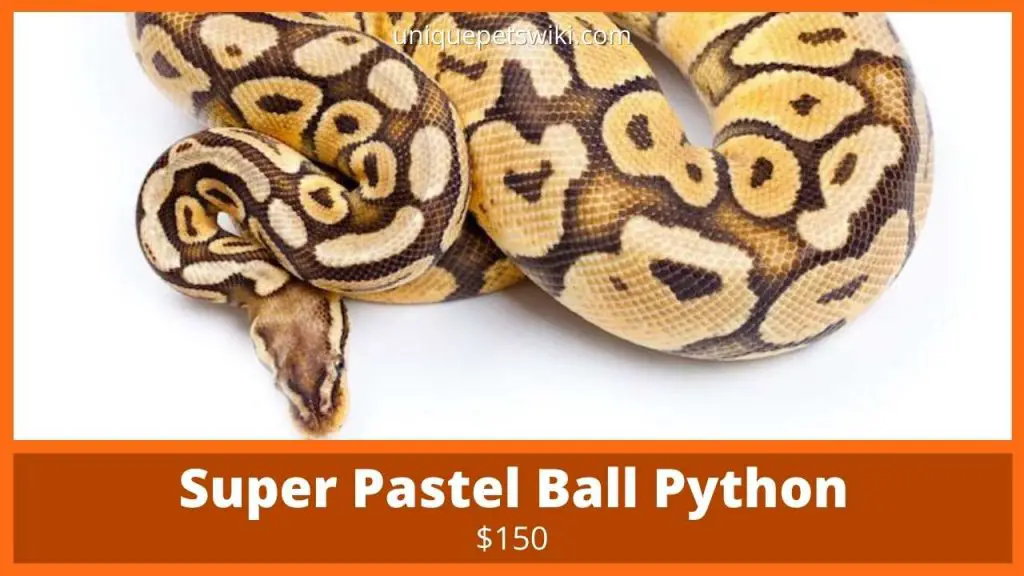
(Image source: worldofballpythons.com)
Pastels are basic morphs that were first bred in 1997, and named Pastel Jungle.
They have a pale head and white lips, and their base color is blushing brown. Though their patterns are normal, their eyes are pale green making them unique from other morphs.
However, when you breed two pastels, they produce a unique morph known as the super pastel. Super pastels have purple-haze (yellow patterns with purplish blushing) colors. Their patterns include erratic, band, and several keyholes blotches.
You can get a pastel morph for $75, but for a super pastel, you need to part with at least $150.
Spider Ball Python Morphs
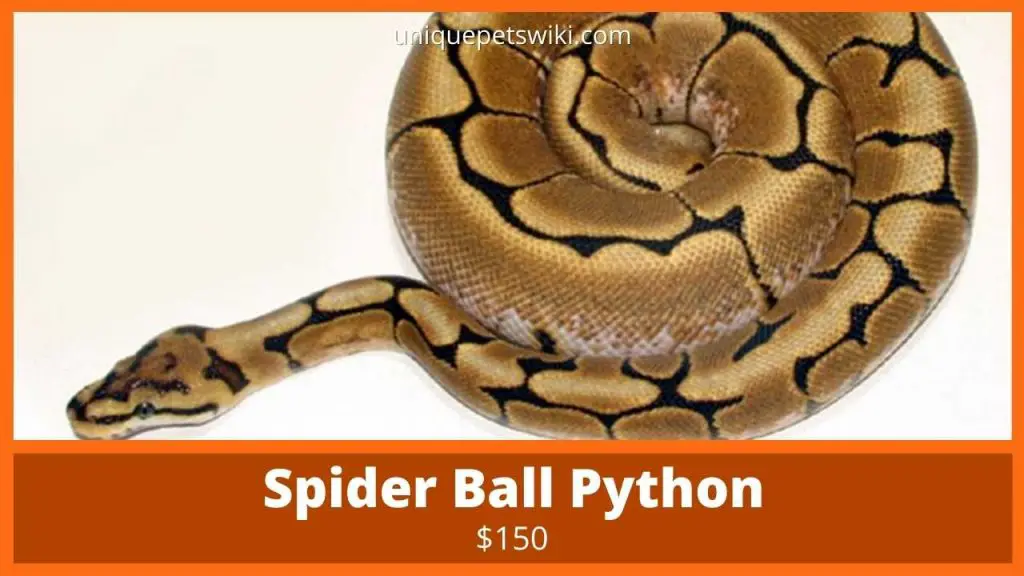
(Image source: worldofballpythons.com)
The unique dominating gene of the spider ball python came into existence in the year 1999.
Their bodies are tan-brown and fade along the belly sides. They also have thin, dark lines and spots across their bodies, similar to their facial markings.
Spider ball pythons are popular, and you can purchase one for $150.
Lesser
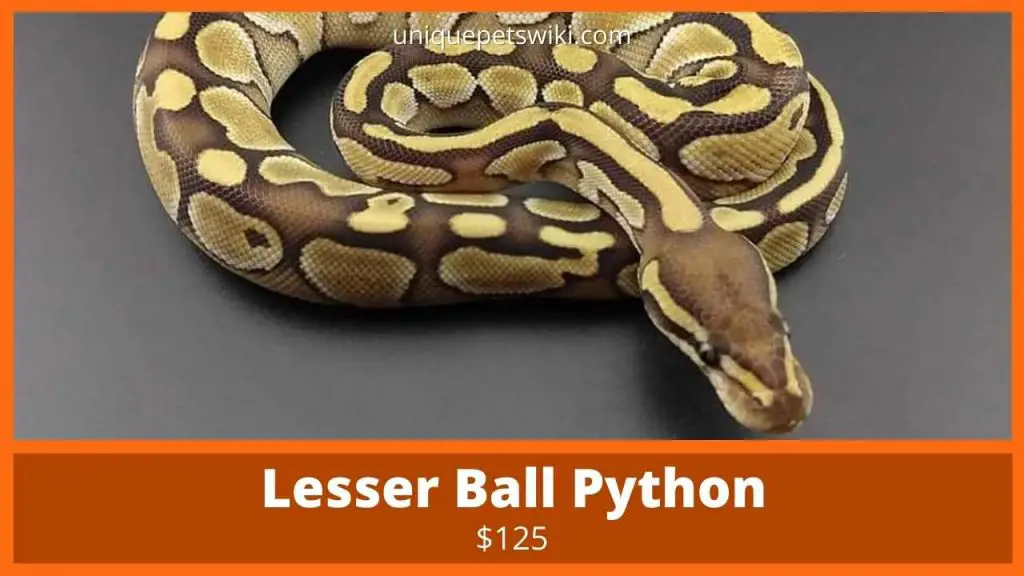
(Image source: worldofballpythons.com)
The lesser morphs are codominant gene pythons that were bred in 2001.
These ball pythons are dark brown and blushed-out, and their colors lighten towards their bellies. They also have light yellow spots throughout the sides and balloon-like splotches on their spines that do not have any spots or disruptions.
Their heads are normal but slightly brown. In the beginning, it was difficult to breed these morphs. However, breeders have found better ways to produce them, and they are now common morphs.
Therefore, you can now purchase these morphs for as little as $125.
Butter
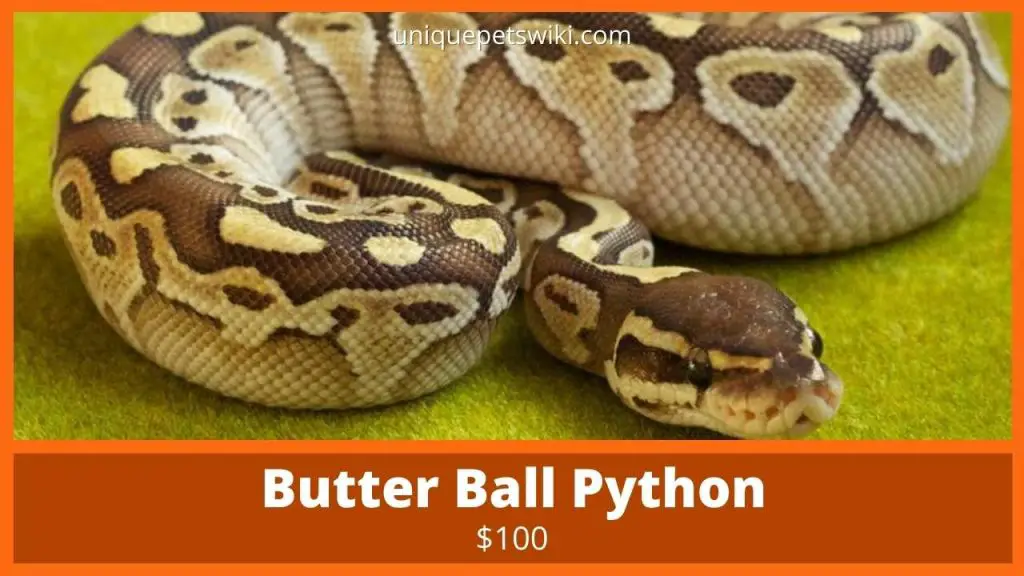
(Image source: worldofballpythons.com)
These are basic morphs with calmer variations of yellow morphs. Even though they are known to be basic morphs, they carry codominant mutation genes that can produce a super butter when bred together.
The butter mutation gene is responsible for producing offspring that have creamy-yellow markings, and caramel-brown highlights.
However, super butter is pale yellow, and you can also obtain blue-eyed lucies from butter though it’s very rare.
These butter morphs are cheapest, among other morphs, and they only cost approximately $100.
Pinstripe
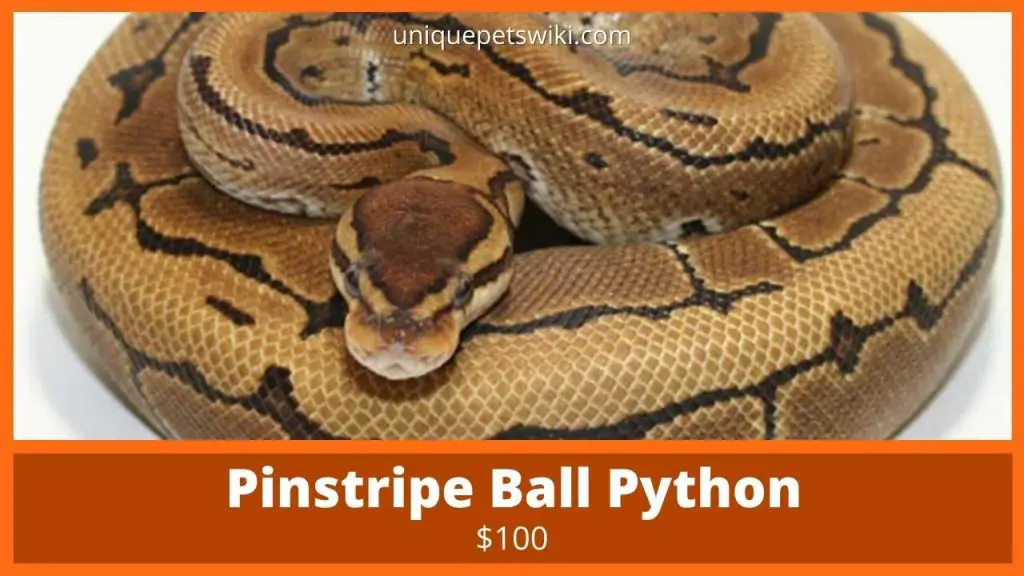
(Image source: worldofballpythons.com)
Pinstripes have a dominant gene that produces a dark stripe along their spine. Even though they are common morphs, breeders love them and use them to create other morphs.
When bred with other morphs, they reduce patterns and also create a prominent spine.
The underlying pinstripes are copper or light brown and have a thick, dark stripe that runs vertically from their head to tail tip. Also, they have thin lines that are perpendicular to the pinstripe.
Pinstripes were first bred in 2001, and they only cost $100.
Vanilla
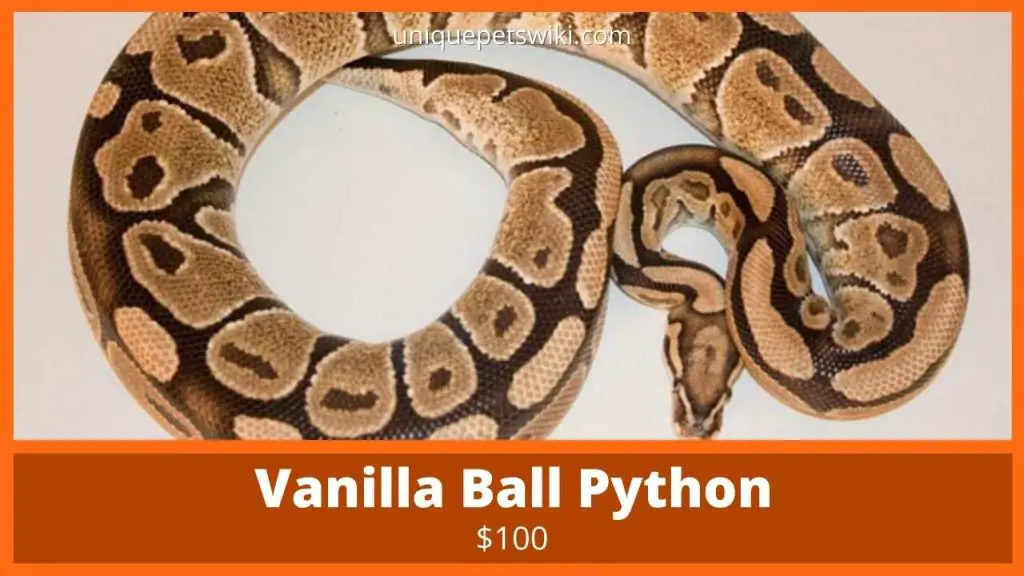
(Image source: worldofballpythons.com)
Vanilla pythons have brown shades that define them. However, when you breed vanilla pythons with other morphs, they can produce different patterns and colors.
They are common morphs among breeders as they use their codominant gene to produce standard patterns and blushed-out brown background colors.
Vanilla morphs have lighter bellies, and they only cost $100.
Ghost
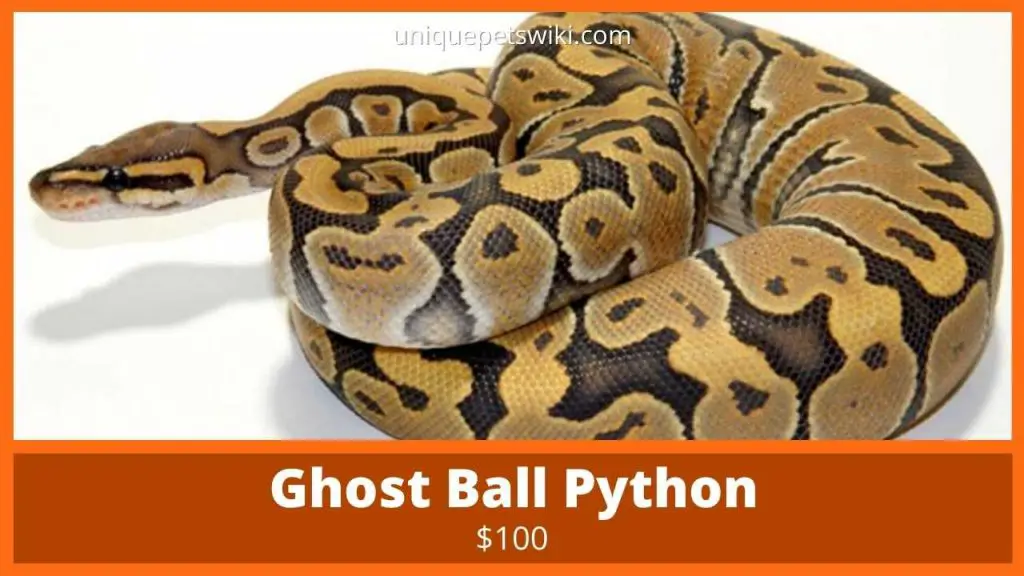
(Image source: worldofballpythons.com)
Ghost ball python morphs are hypomelanistic. Thus, they carry a recessive gene that helps to reduce pigmentation in other morphs.
The first ghost morph was produced in 1994.
They have a typical pattern, except their colors are pale. They come in grey, yellows, or tan colors, and they can produce amazing morphs.
Thus, if you would like to own one of these morphs, be ready to pay at least $100.
Red
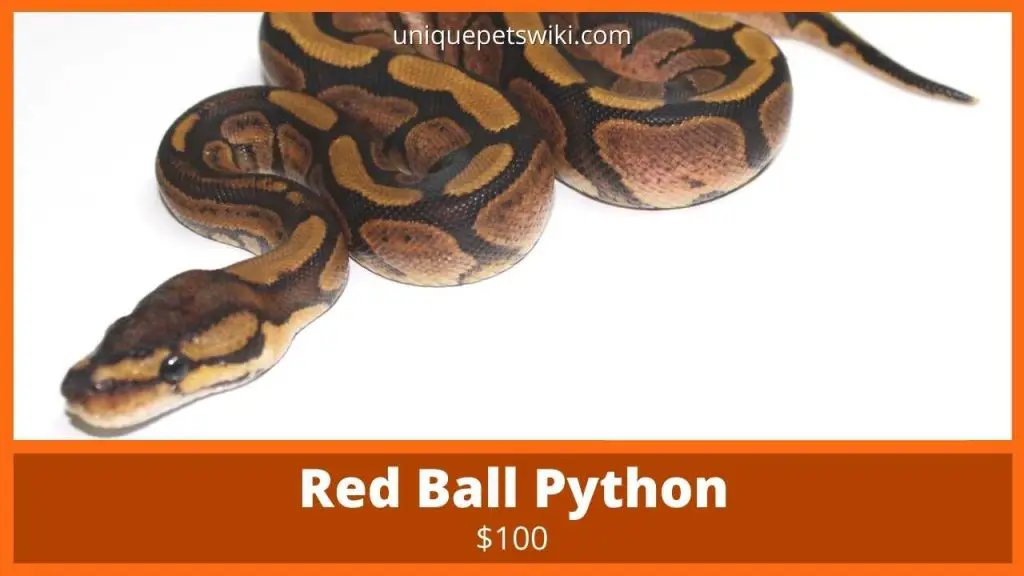
(Image source: worldofballpythons.com)
Red morphs carry a dominant gene that can only affect colors. Their blotches have normal patterns, but just like their name suggests, their undertones are deep red.
Breeders love to use these morphs to produce other morphs that carry the red hues and copper.
If you would love to have one of these morphs, it will only cost you $100.
Phantom
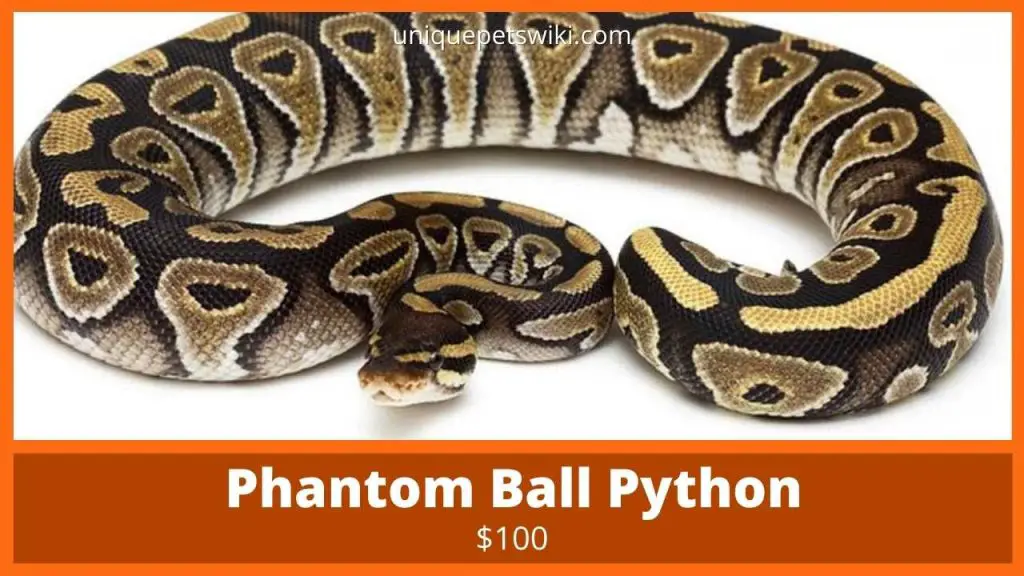
(Image source: worldofballpythons.com)
Phantom morphs carry the same gene as the mystic morphs. Their base color fades from black to tan towards their white belly.
They also have yellow patterns that appear dark golden with alien heads and black spots. Their spines have spots and stripes that run through their tail.
The first breed of the phantom was accidentally produced in 2001 but was proven in 2005.
Phantom ball pythons cost $100.
Chocolate
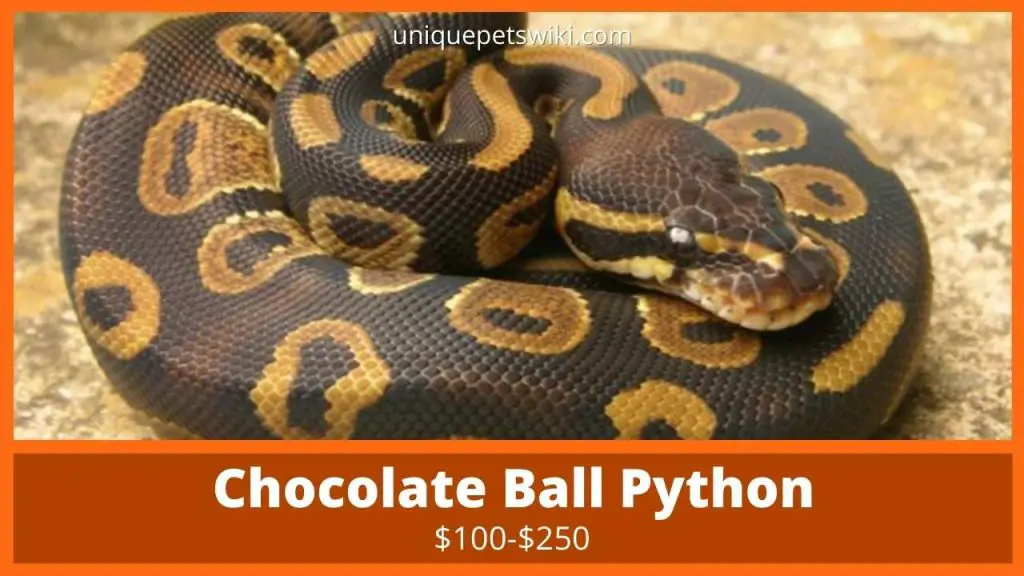
(Image source: worldofballpythons.com)
The chocolate ball python gene was recognized as a dominant gene in 1999. Their names tell it all as their base color is chocolate-brown. They also have caramel keyholes and alien head spots.
These spots are dark at the center, and they have a balloon shape. Their heads are normal, but along their spines, they have caramel spots.
Even though chocolate ball pythons are popular, a morph can cost you $100 or even $250 for the ones with intense colors.
Ghi Ball Python
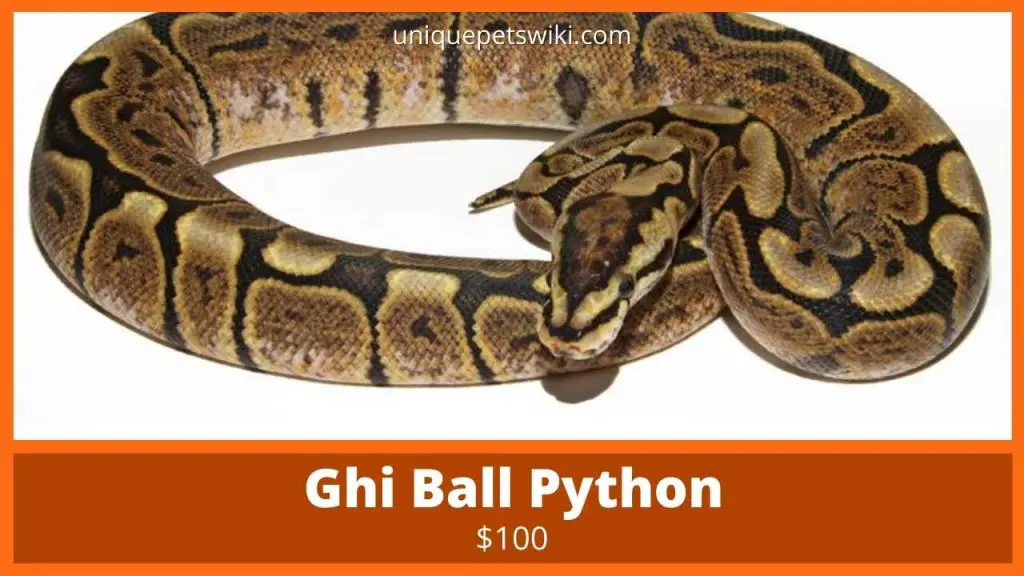
(Image source: worldofballpythons.com)
These codominant morphs were first discovered in 2007.
Ghi Ball pythons have black background color at their back and patternless bellies that are light in color.
Ghi Ball pythons also have orange-brown blotching patterns that are filled with black specks and spots. Before their belly, the black base color appears faded, especially between the blotches, making the linings look like flaming silver at the lower edges.
These African natives ball pythons thrive in captivity, and a morph sells at $100.
Enchi
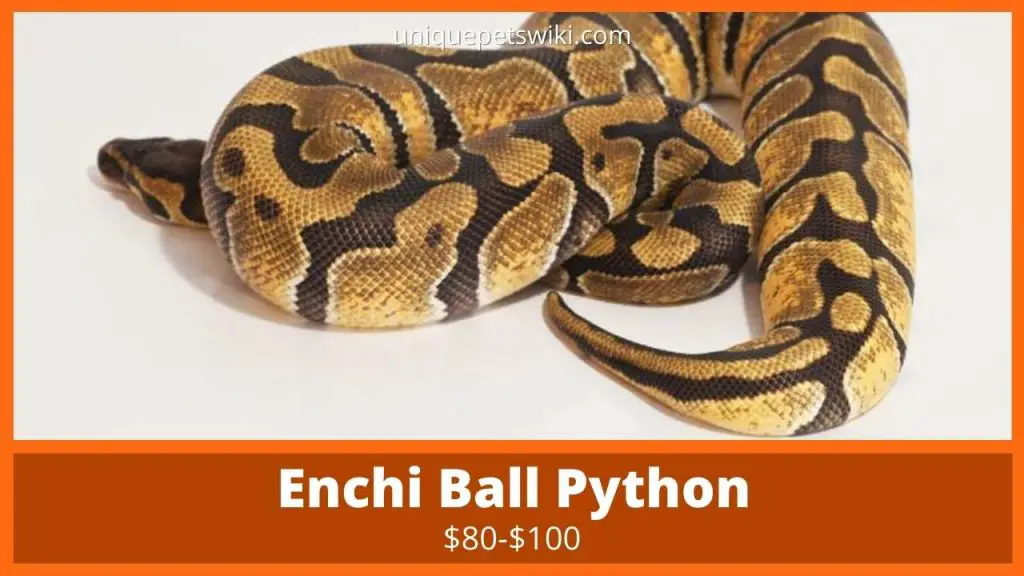
(Image source: worldofballpythons.com)
Enchi Ball pythons are basic morphs with orange-tinted sides, and blushing, round patterns at the back of their heads.
When you breed Enchi morphs with other pythons, they produce codominant genes. Thus, their offspring come out with more defined patterns.
However, the offspring colors appear undefined, but as they mature, their color becomes more intensified.
These standard morphs are inexpensive, and you can get one for $80-100.
Yellow Belly
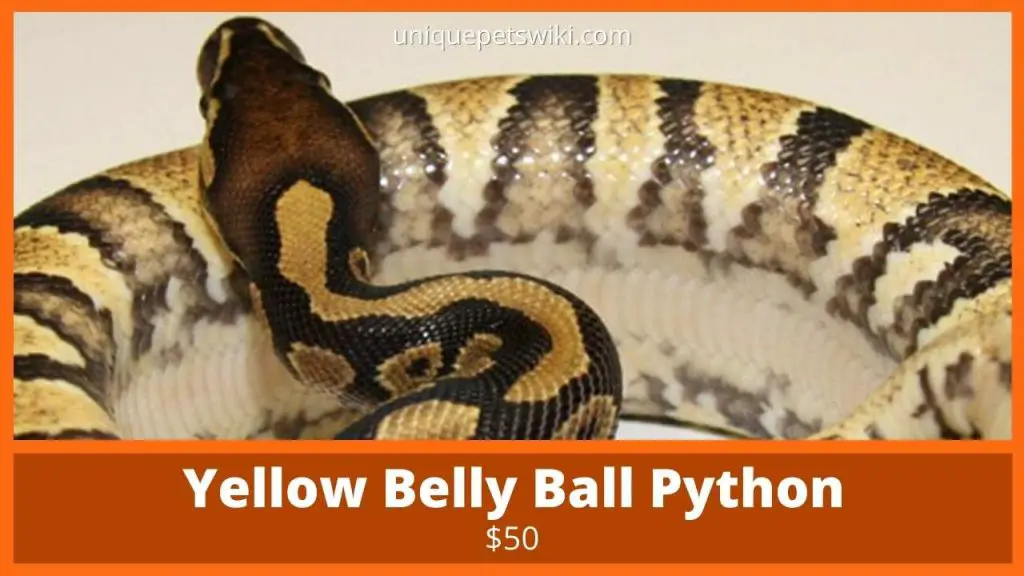
(Image source: worldofballpythons.com)
The yellow bellies were bred from the codominant gene in 2003.
Yellow bellies have unnoticeable color change from the normal ball pythons except that they have a yellow-tinted, clean belly.
Some can appear with a flaming or a blushing belly side, making them more distinct from the normal ball pythons.
The yellow belly is inexpensive and only costs $50.
Stormtrooper Morph
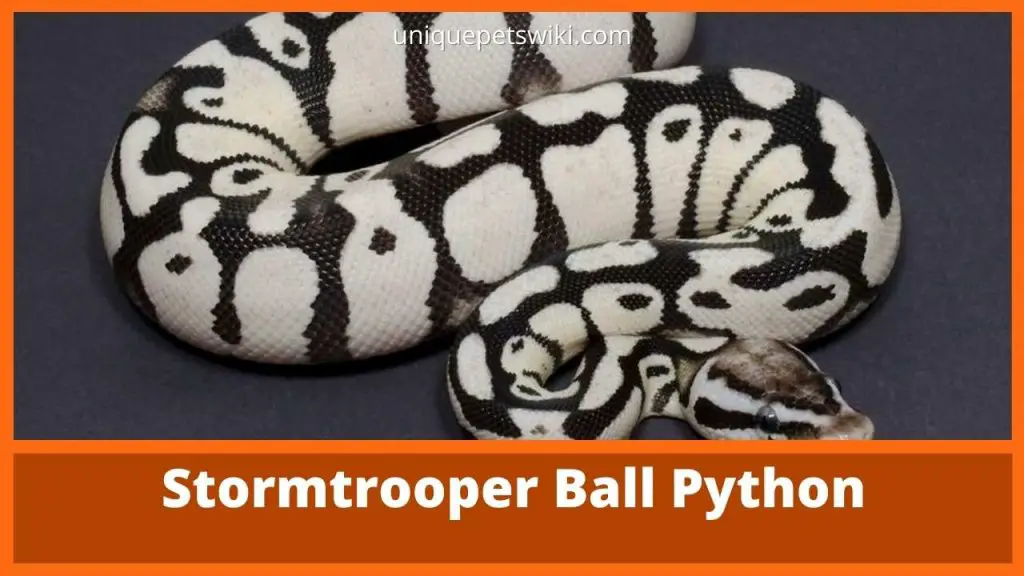
The stormtrooper ball python was an accidental morph that was bred in 2015. The breeder intended to create an Axanthic X Pastel.
Unlike the Axanthic pastel morphs, the stormtrooper has an increased melanin production. Thus, the black pattern overtook the white portions creating a gene known as darkness.
This morph has not been reproduced yet, and thus it cannot be sold.
We are through discussing some of the top 50 ball pythons. But, these morphs were produced from 2015 backward.
As we said, earlier ball python breeders have continued to create more morphs up to now. Thus, let’s look at some of the newest morphs created in 2020.
New Ball Python Morphs Discovered In 2020
Ball python breeders continue to create more unusual morphs. Creating new ball python morphs is as simple as breeding ball pythons.
However, to create unusual breeds, you must use selected breeds to create new morph with unique and unseen before colors and patterns.
Here are some of the newest morphs created in 2020.
Mojave Albino Pied
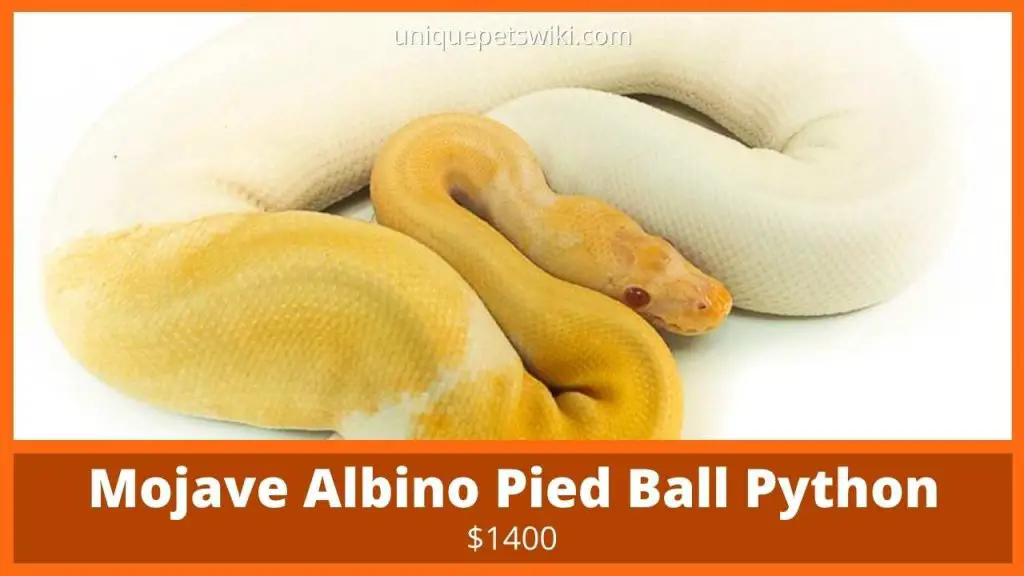
(Image source: worldofballpythons.com)
The new morph of Mojave Albino Pied is a pure white morph with a light yellow pattern around the head and neck.
It was first bred by mixing piebald, Mojave, and Albino genes by The Florida Reptile Ranch. Thus, the morph carries characteristics of all the three mentioned morphs.
The breeders first posted the morph in August 2020. Currently, a baby morph of Mojave Albino Pied costs $1400. The total weight of the baby morph is 125g.
If you would like to buy this morph, you can order this breed following this link.
Enchi Pied
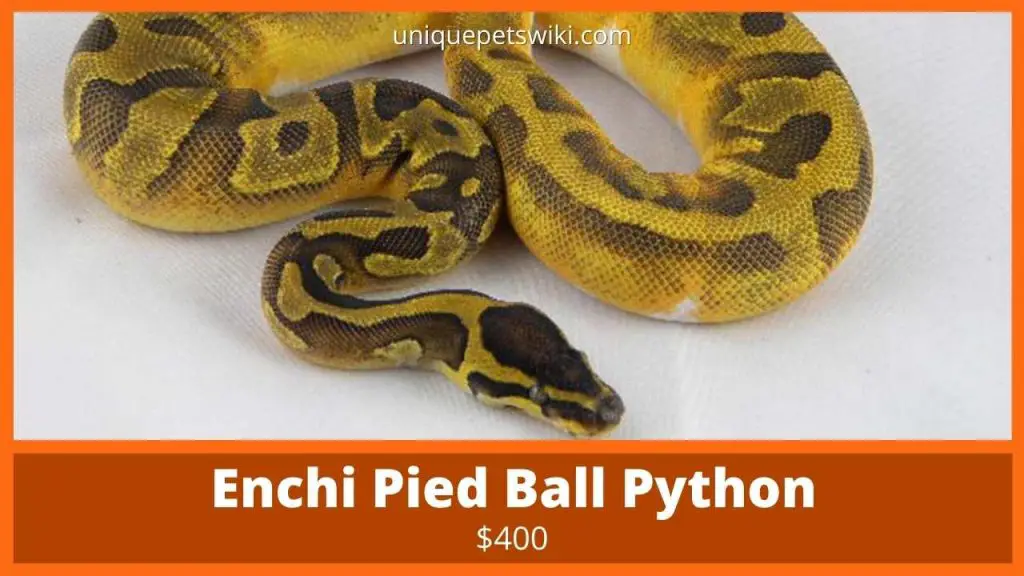
(Image source: worldofballpythons.com)
Enchi pied is yet another newest morph produced by Florida Reptile Ranch. It carries both the piebald and Enchi traits.
To produce an Enchi Pied morph, the breeders had to mix a codominant gene of Enchi with a recessive Piebald gene.
The result was terrific as Florida Reptile Ranch was able to produce a new designer called Enchi Pied morph.
The Enchi Piebald has a white base just like the piebald, and the orange color in it is more defined than the original Enchi.
A baby/juvenile morph weighing 150g is currently selling at $400.
Albino Pied Ball Python
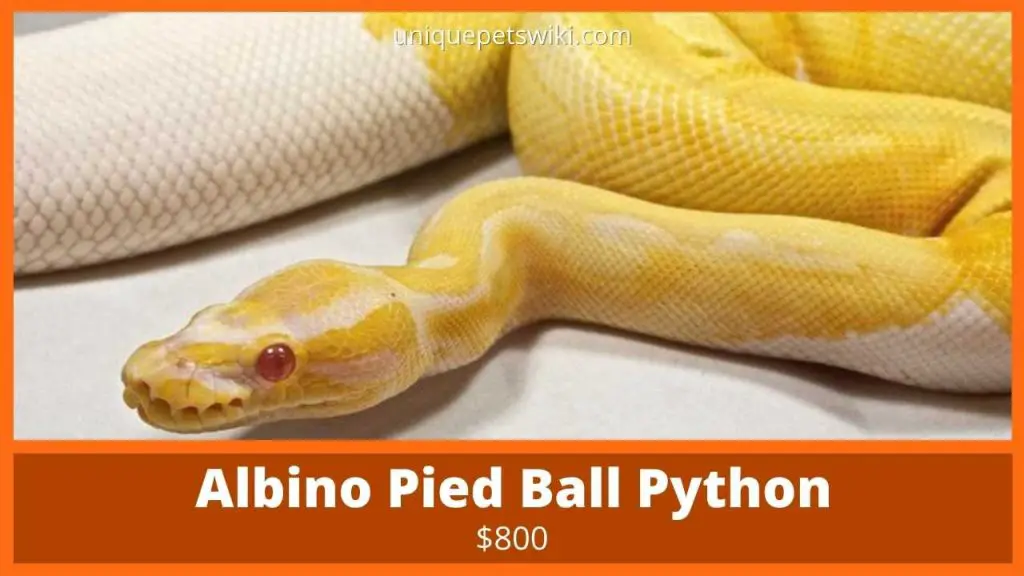
(Image source: worldofballpythons.com)
Are you an albino lover? Good news for you. Florida Reptile Ranch has been able to produce a new morph with Albino, Piebald, and Leopard traits.
The morph has a white base with orange leopard-like patterns. Additionally, towards the end of the tail, the morph has a large white portion resembling the piebald.
The morph was produced by mixing two recessive genes of piebald and Albino, and a dominant leopard gene.
Albino Pied Ball pythons are some of the newest morph created in 2020. The first morph of this kind was posted on the 18th of August 2020.
If you would love to own one of these morphs, a 125g baby/juvenile Albino Piebald python can cost you up to $800.
Ghost Pied Ball Python
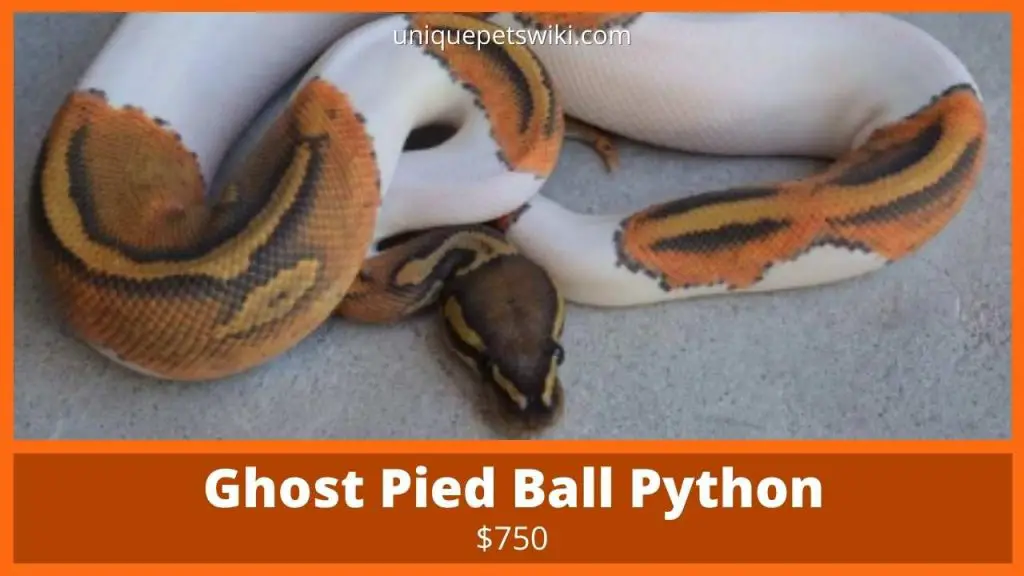
(Image source: thefloridareptileranch.com)
Ghost pied are new morphs created in 2020 by the Florida Reptile Ranch. They are beautiful morphs that carry a piebald and ghost traits.
Their physical appearance can tell it all as these morphs large white portions just like the piebald. However, unlike the piebald, ghost pied white parts are more spread.
The morph also has ghost morph characteristics as it has shades of yellow, brown and grey, and a faded head.
Ghost pied morph is a mixture of two recessive genes, which are piebald and ghost.
You can own one of these new morphs at $750.
NR Mandarin Pastel Enchi Fire Ball Python
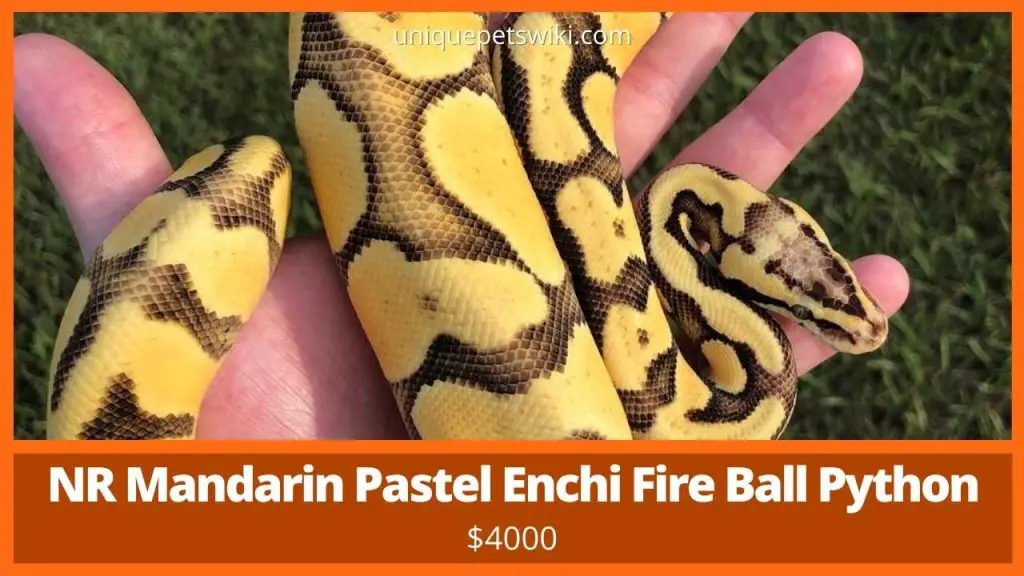
(image source: morphmarket.com)
Mandarin Pastel Enchi Fire is another new morph that has been lately introduced to the market by Florida Reptile Ranch.
The first morph of this kind was created in 2019. However, in 2020, the Florida breeders developed the morph to develop even a newer morph known as Mandarin Pastel Enchi Fire.
The morph carries the traits of all the morphs. It almost looks like a leopard pastel, but its colors are more faded.
Suppose you would like to have one of these beautiful morphs ready to part with $4000. It is currently the most expensive morph bred in 2020 by Florida Reptile Ranch breeders.
Pastel Ghi Clown
Pastel Ghi Clown is one of the latest morphs created By Royal Constrictor Designs.
It has the traits of Ghi, pastel, and Clown. Thus, it carries both co-dominant and recessive genes. The recessive gene of a clown causes a reduced pattern.
It currently costs $1350.
Lesser Ghi Ultramel
This beautiful morph is a combination of co-dominant lesser Ghi and ultramel recessive gene.
It was domestically bred and produced by Morph Jungle in 2020, and it currently costs $2000.
Bumblebee Freeway
Bumblebee freeway carries the traits of Asphalt, Pastel, Yellow belly, and spider.
Due to freeway genes, the bumble freeway has very bright yellow coloration with dark border patterns.
Bumblebee freeway was created by morph jungle and can be purchased from morph market site at $1,100.
Ball python morph list can go on and on as breeders keep creating more. We have given you some of the latest morphs produced in 2020.
Let’s now look at how much ball python species can cost.
How much Do Ball Python Actually Cost as Pets?
Would you like to keep snakes as pets? You have probably done your research, and you already know that ball pythons make great pets.
Cost for Species
But how much does ball python cost as pets? Well, normal ball pythons are inexpensive, and you can get one for less than $40.
However, if you would love to own one of those designer morphs, you must be ready to pay a higher price than $40.
Breeders have been making attempts to create more designer morphs. In their endeavors, they have managed to create beautiful and rare morphs.
To own one of those rare morphs can be challenging in the beginning as they are usually so expensive.
For instance, in 2012, a stranger ball python was created, and it was sold at $20,000. The first lavender albino ball python was sold at a significant amount of about $40,000. Thus, the lavender albino ball python is one of the most expensive ball pythons ever sold.
However, the prices of these morphs have now gone down to $250 as they are now common.
Several factors affect the price of a ball python morph. These factors include:
Rare Morphs
A ball python can be considered as a rare morph when;-
- It’s newly bred, and only one breeder has it.
- It can affect the offspring’s color and pattern and produce a morph that has never been seen before.
- It’s created from recessive genes that are hard to breed.
Paradox Morphs
These morphs come as an accident without any explanation. Paradox ball pythons come with mismatched patterns and colors that are genetically impossible.
When a paradox morph occurs, it is more highly to cost a significant amount since it’s considered a rare morph.
These are the primary reasons that may affect the price of the ball python. Thus, how much you get your ball python depends on the kind of morph you want.
Cost for Accessories
Before owning a ball python pet, it is necessary to create a suitable habitat for it. Suitable habitat includes;
A Vivarium
A vivarium is your ball python’s house. It can cost you between $60 to $500 depending on your needs.
The second thing you must include in your ball python’s habitat is accessories to mimic their natural habitat. These accessories include
- Basking bulb $3-12
- Heating $25-70
- Substrate $5-30
- Décor (Vegetation, background, water bowl) $70
Cost a Vet
It can be quite costly to pay vet services every time your ball python has health issues. Thus, the best way to ease the burden is by ensuring your ball python.
However, vet services may vary depending on your area.
Well, to own a common ball python as a pet, you will require approximately $200.
Summary
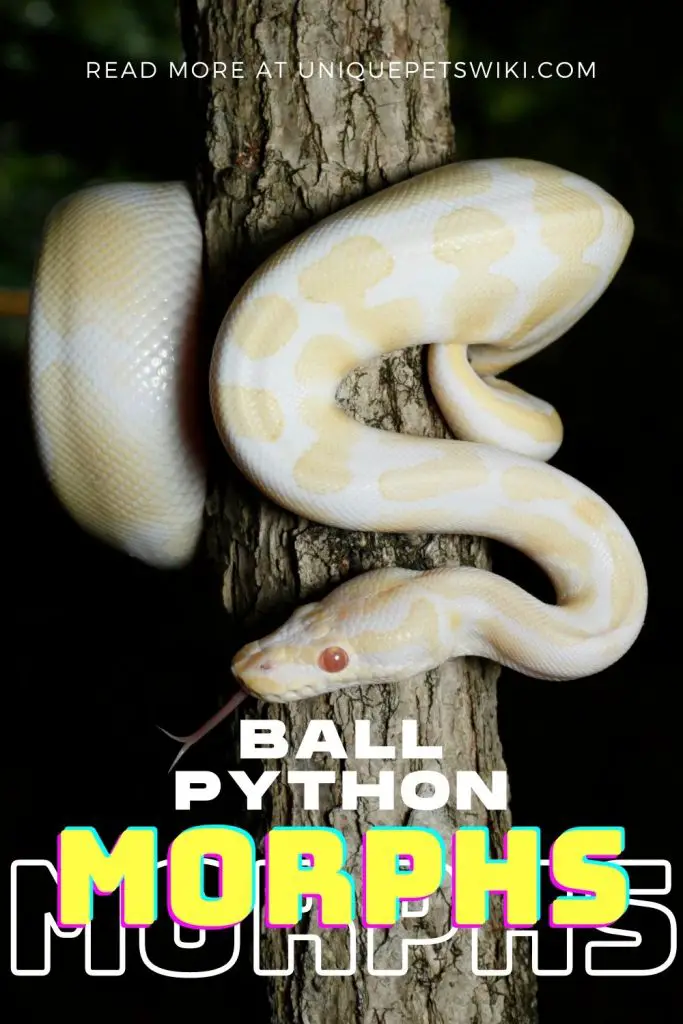
Ball pythons are fantastic creatures that can keep your eyes glued to them. They are beautiful, attractive, and gentle and loved by many pet owners.
Breeding ball pythons to create new morphs can be challenging and expensive. However, the process is rewarding.
Thus, whether you are a beginner or an experienced herpetologist, ball pythons make great pets that can allow you to create even better morphs.
There are thousands of available morphs in the market. In our list, we only have approximately 55 morphs. Therefore, keep checking our site to learn more about these morphs.
